UNIT 1 THE RUSSIAN FEDERATION GREAT RUSSIAN CITIES
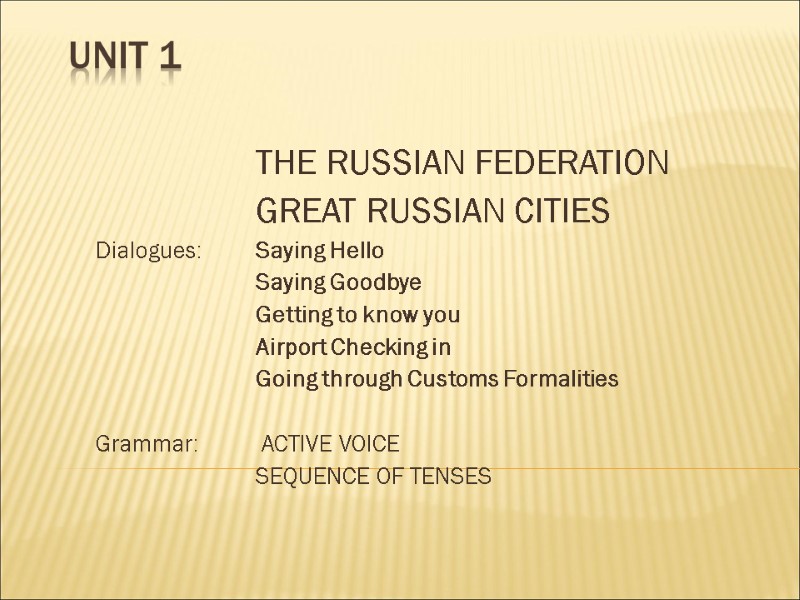
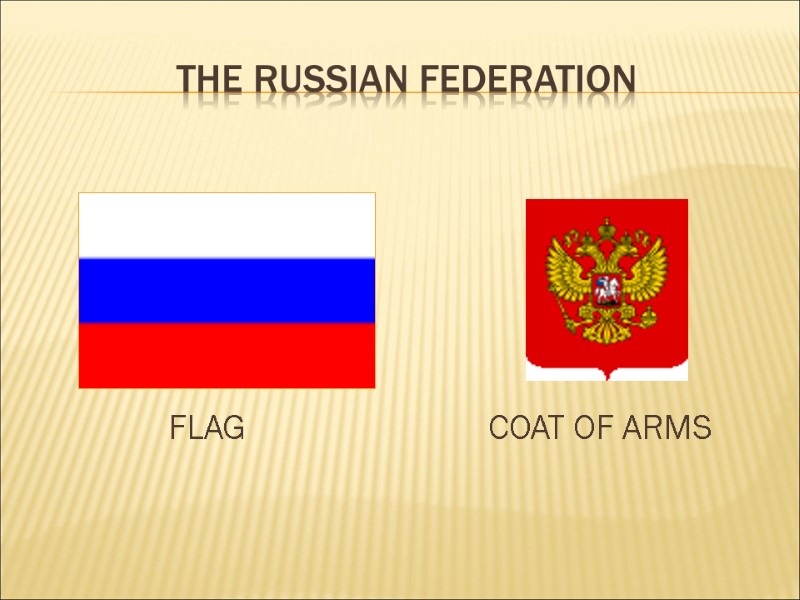

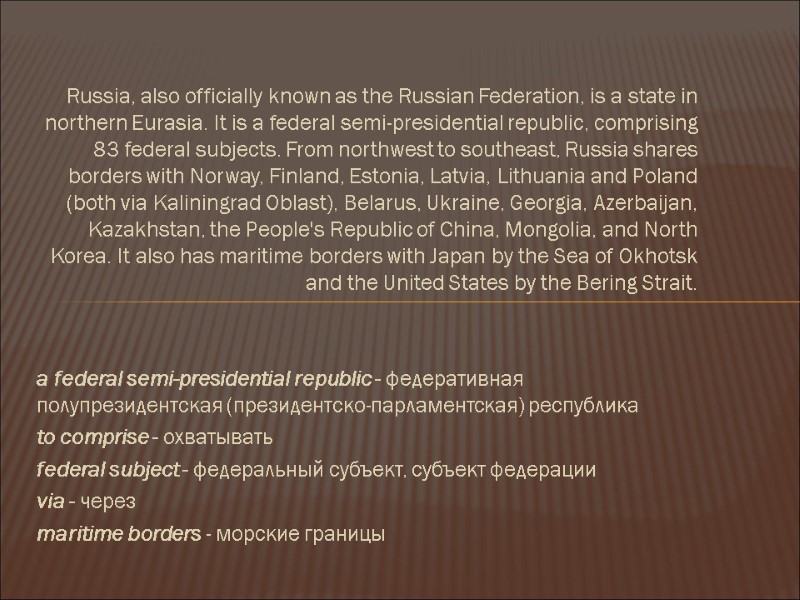
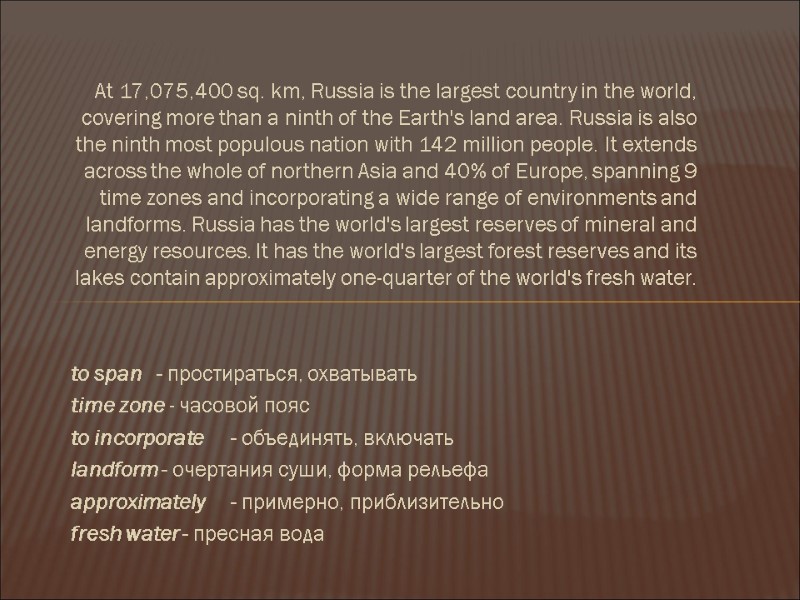
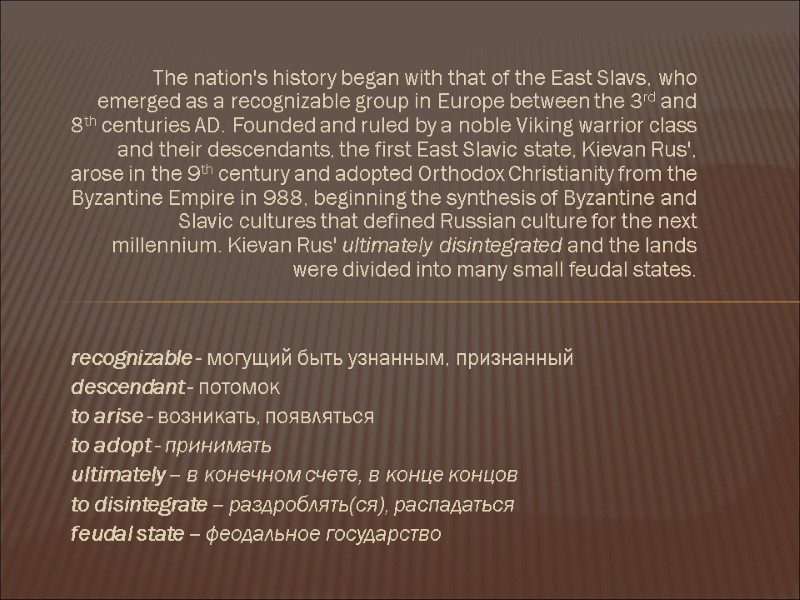
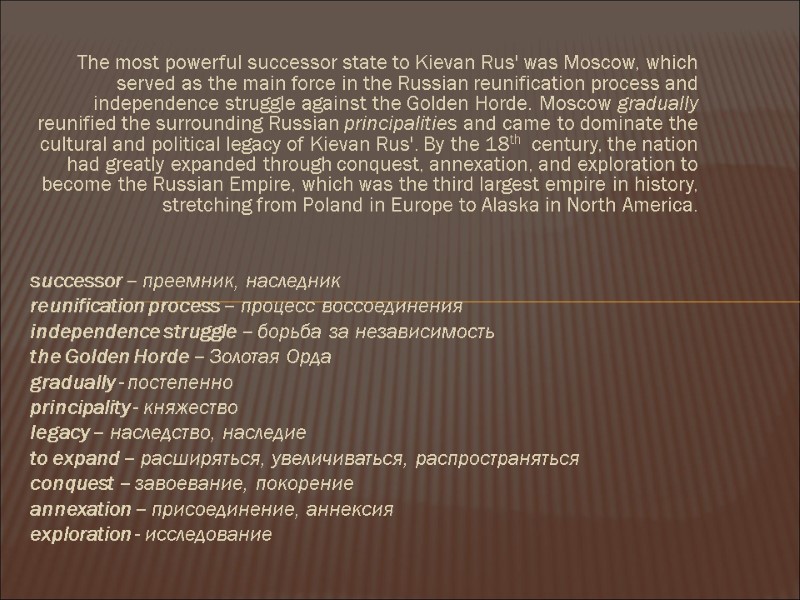
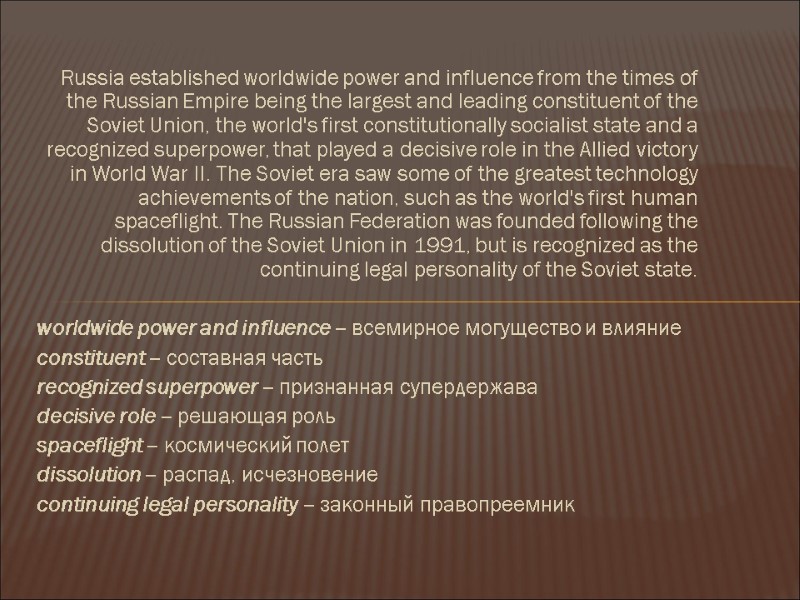
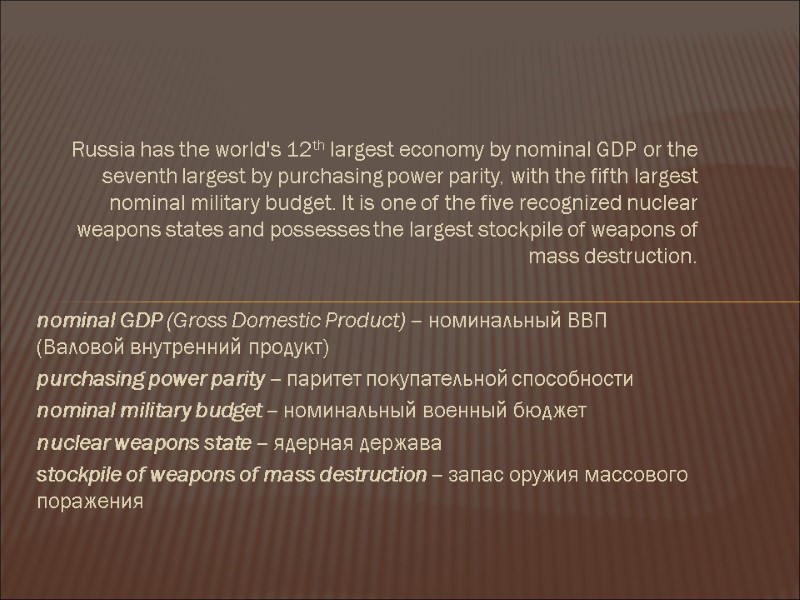
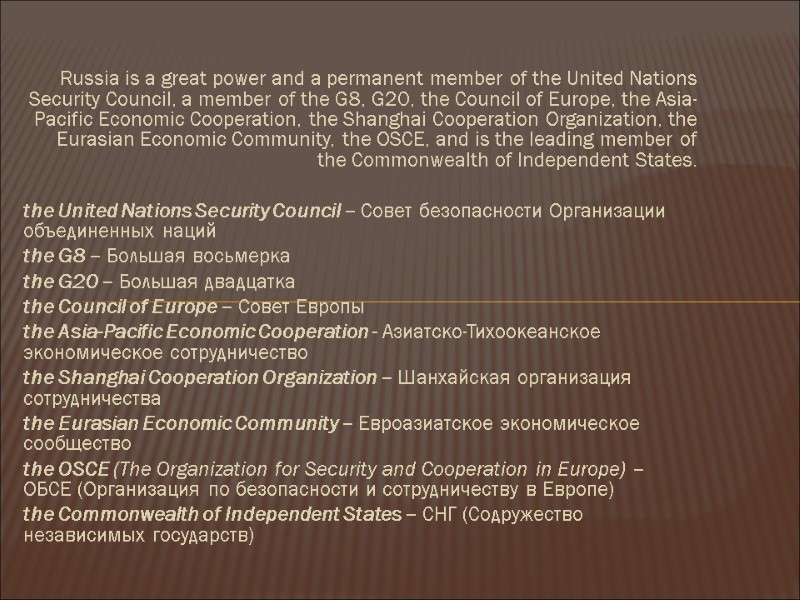
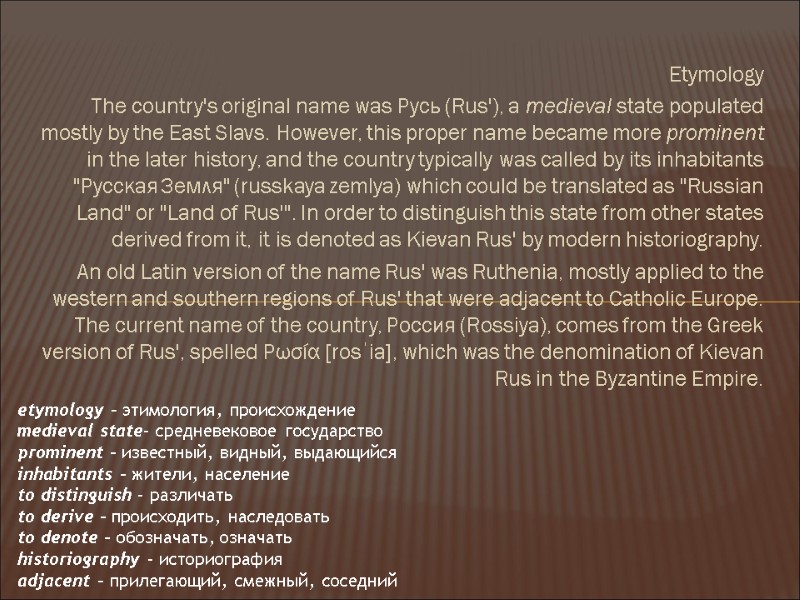
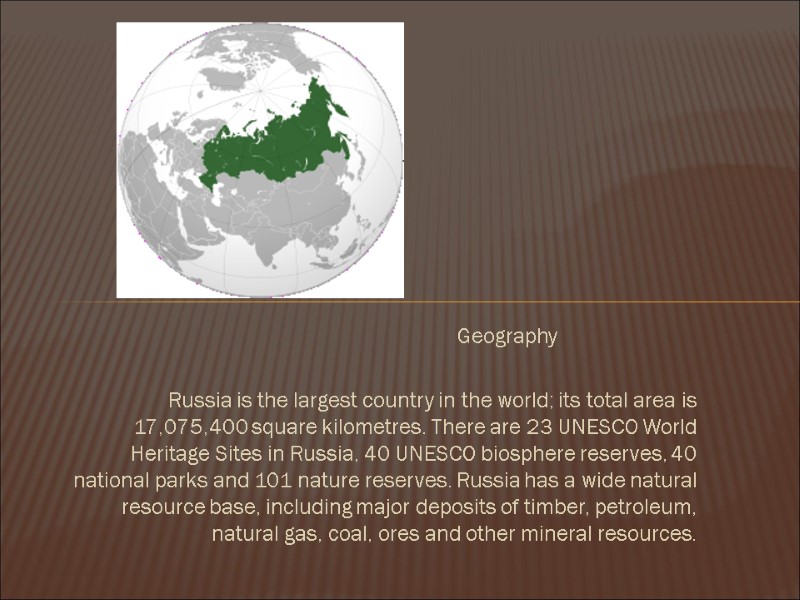
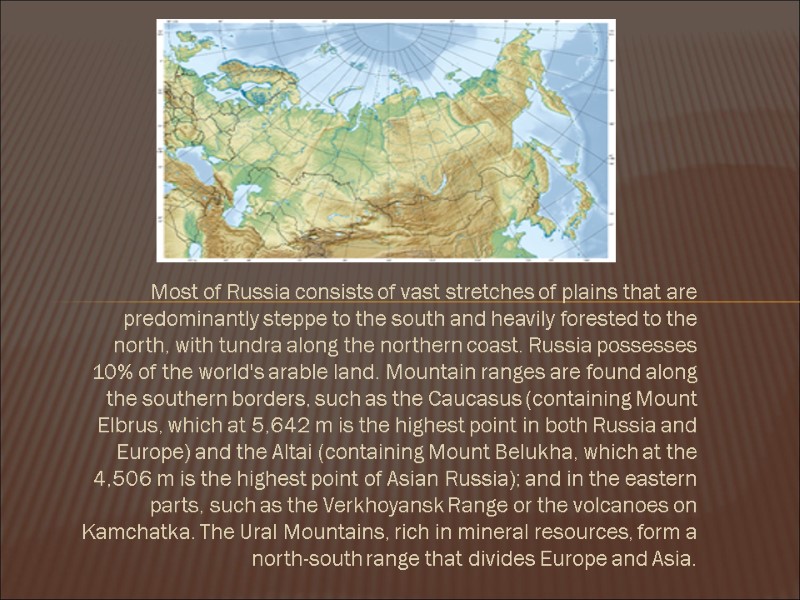
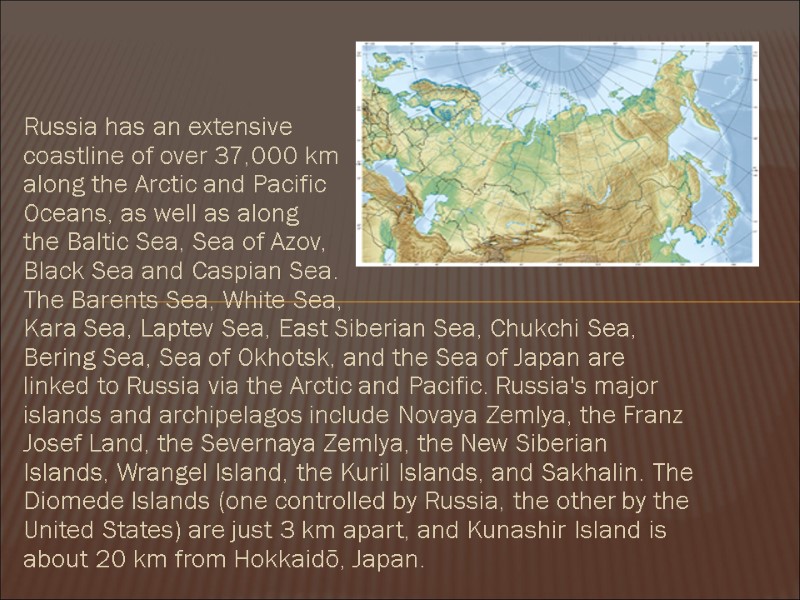
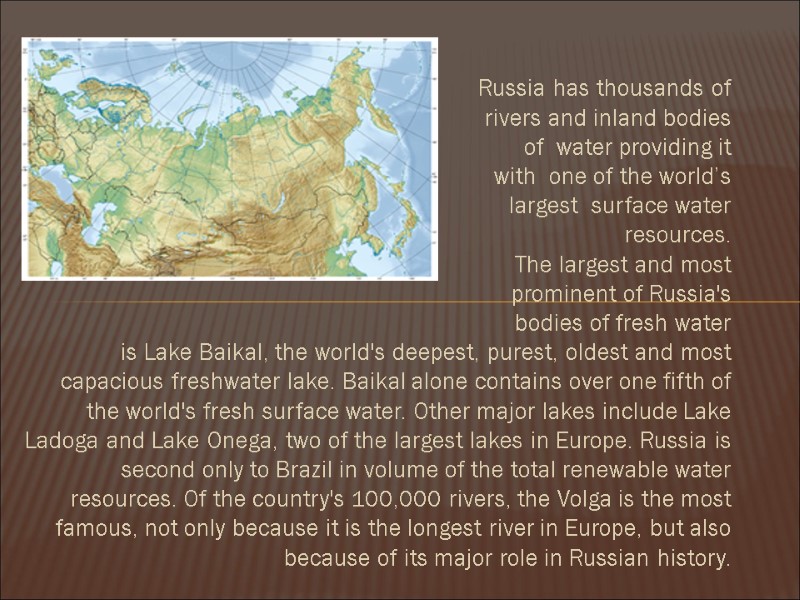
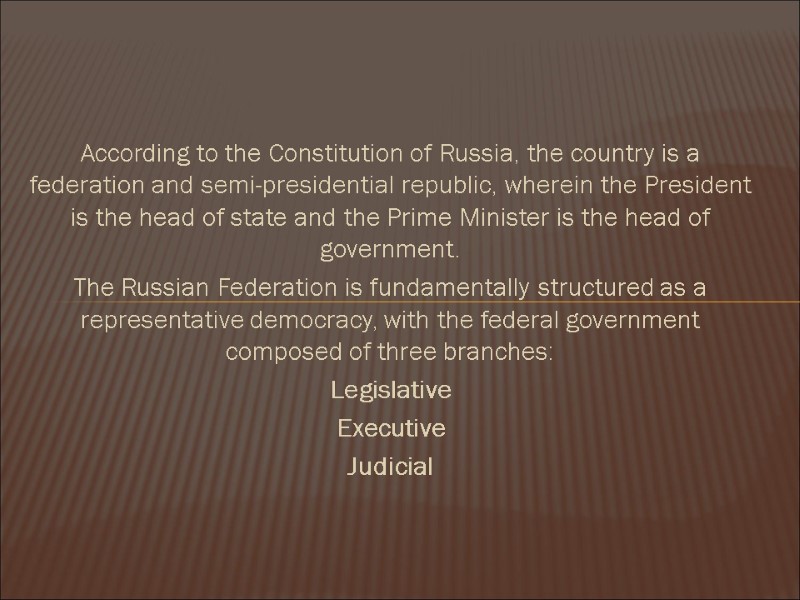
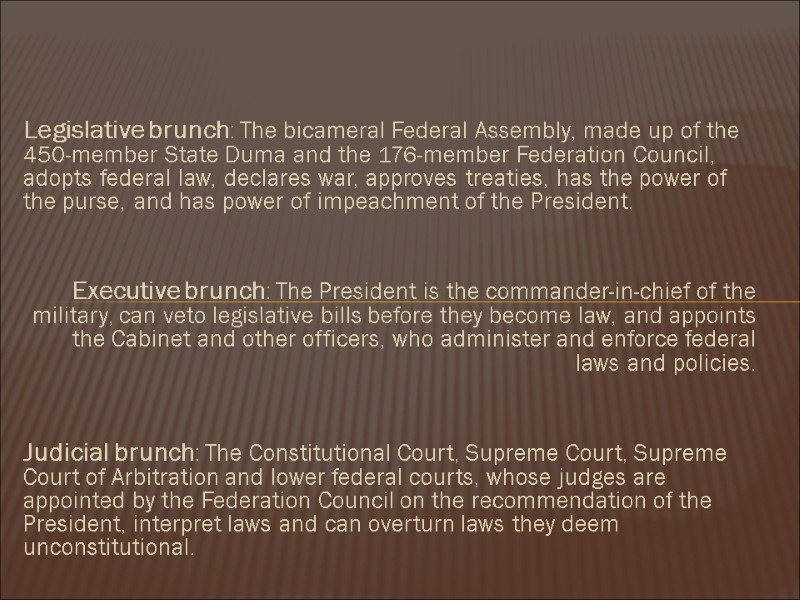
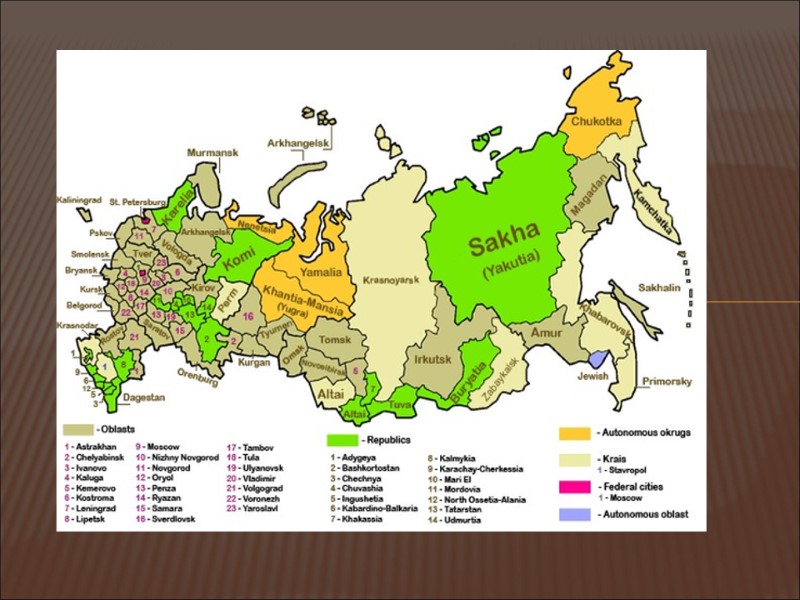
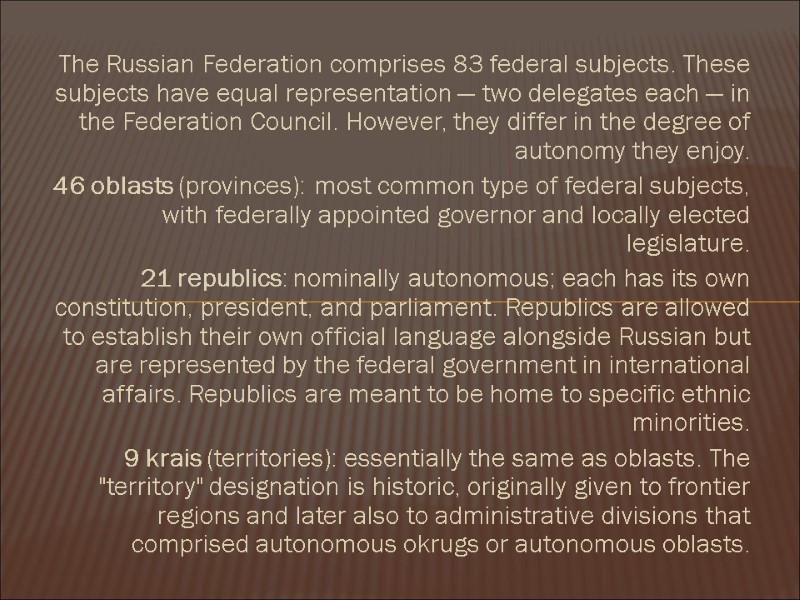
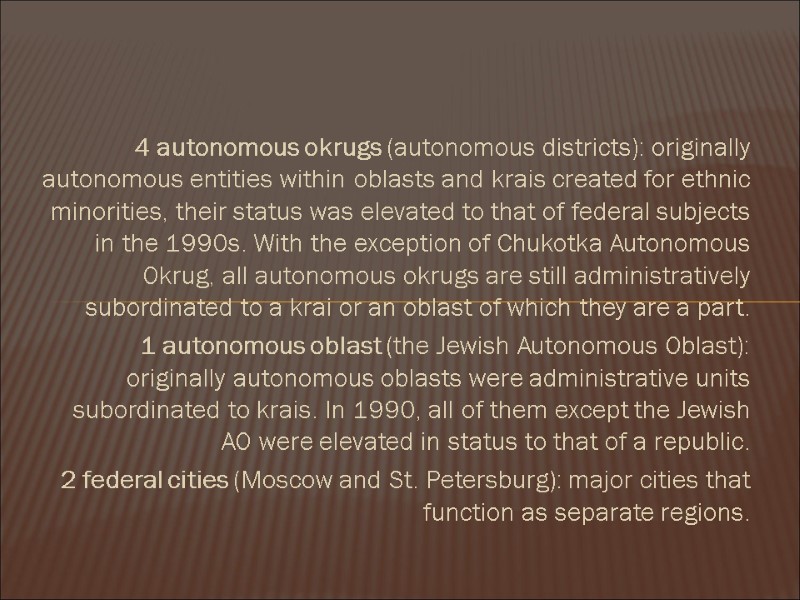
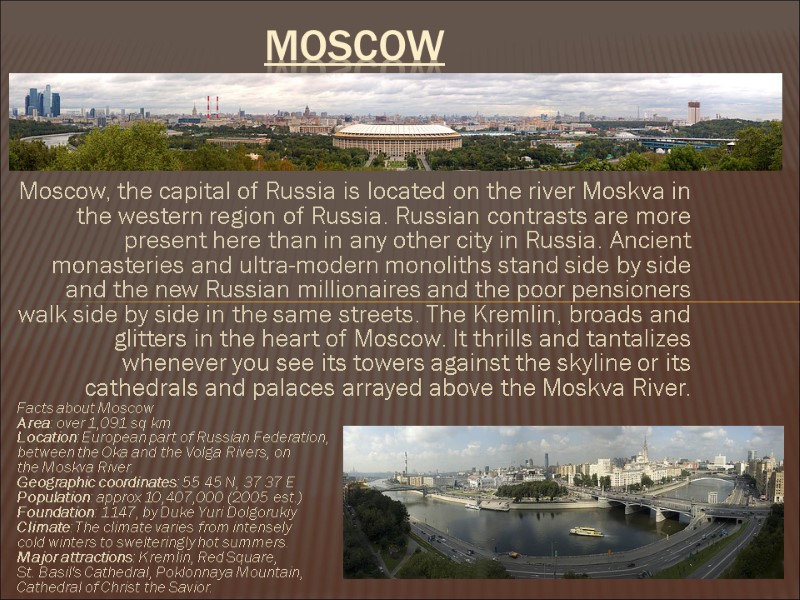
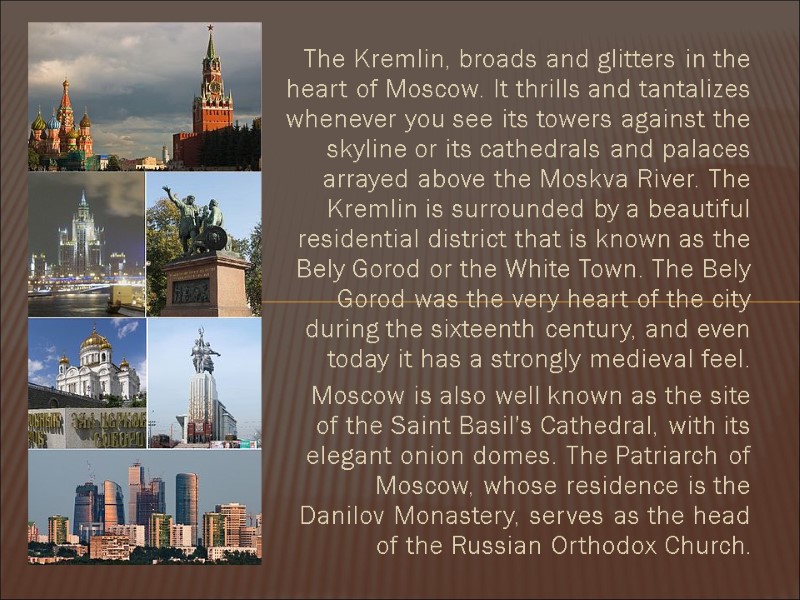
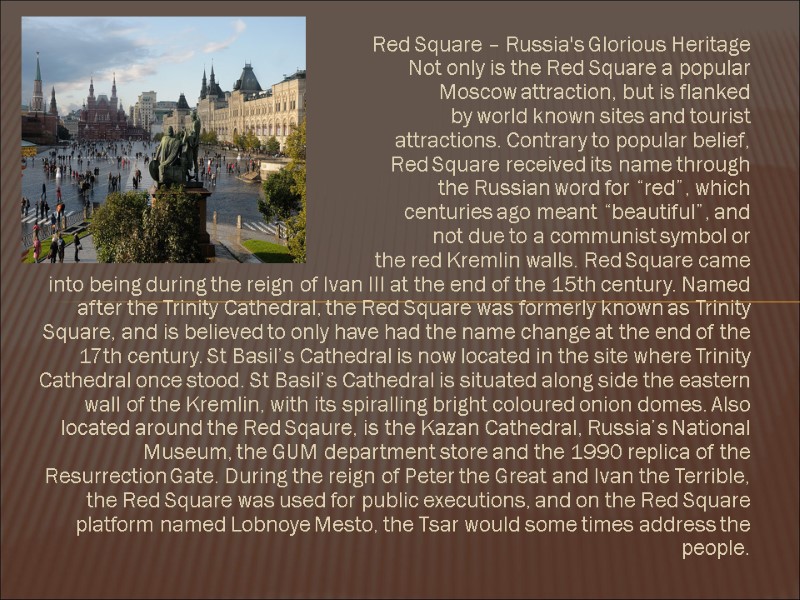
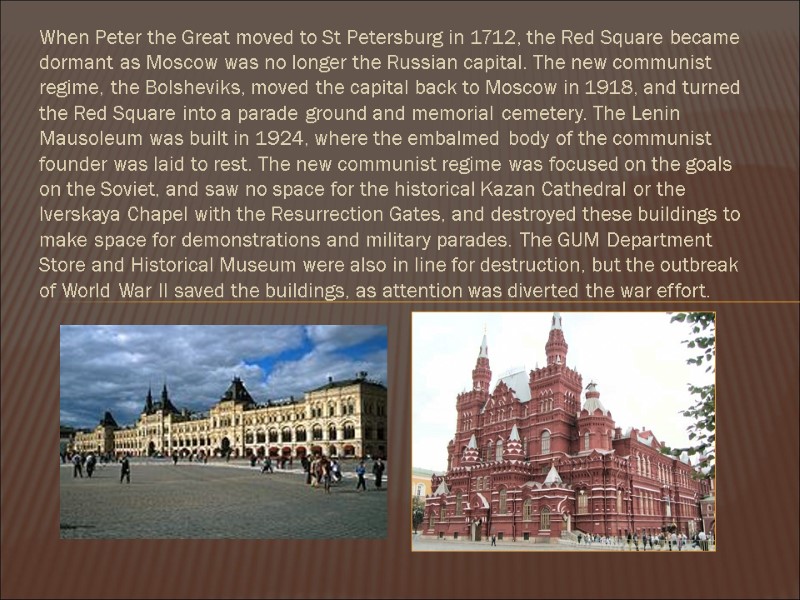
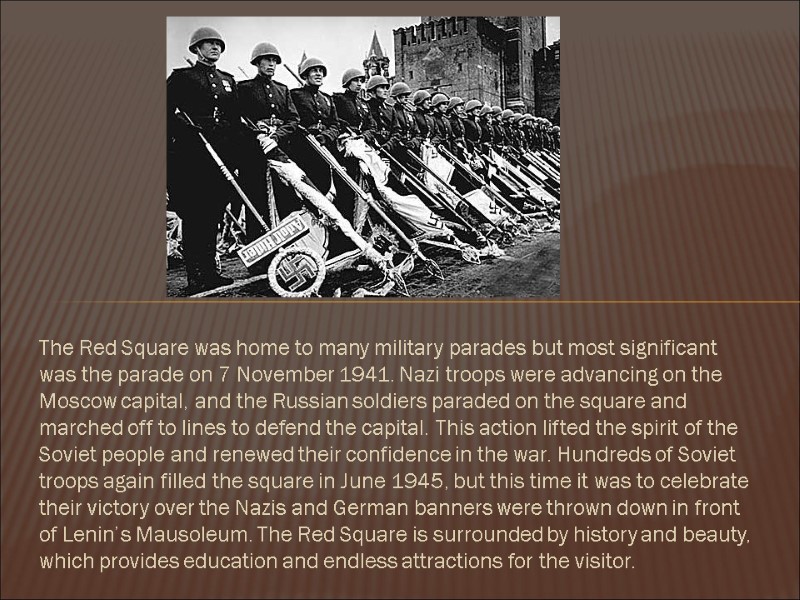
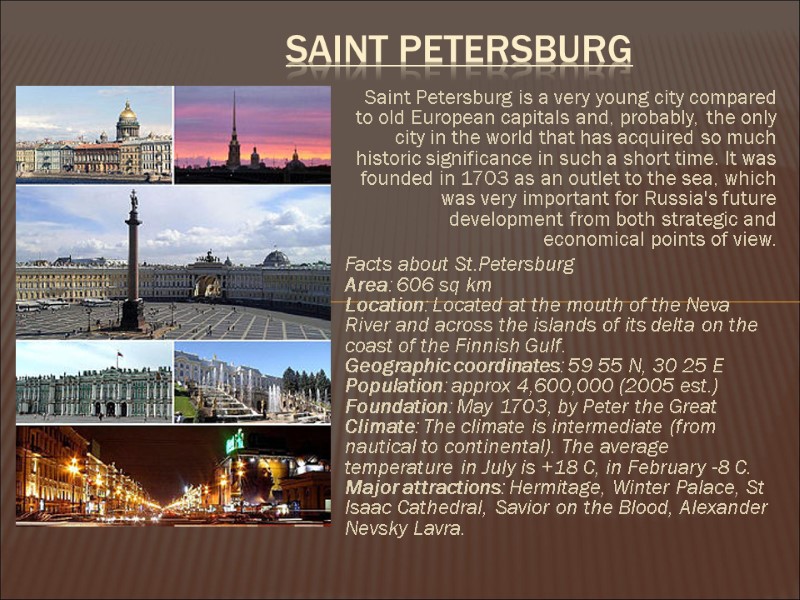
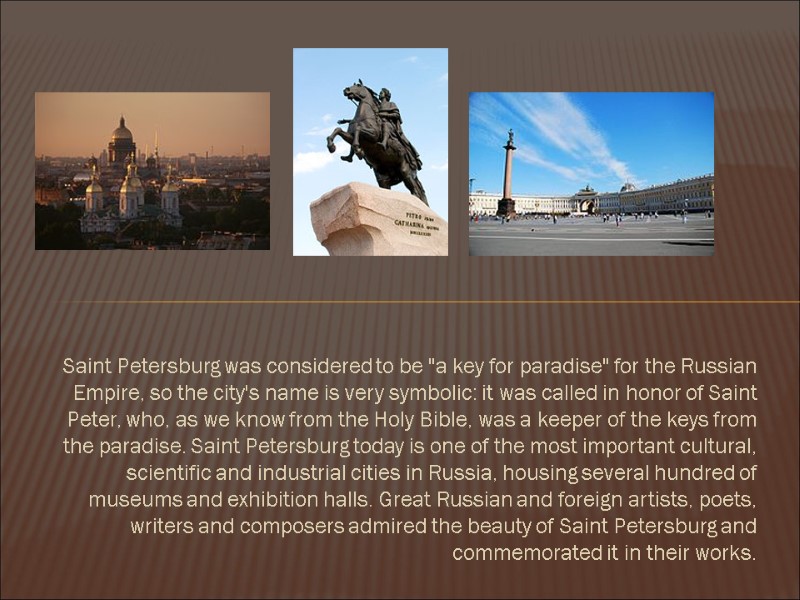
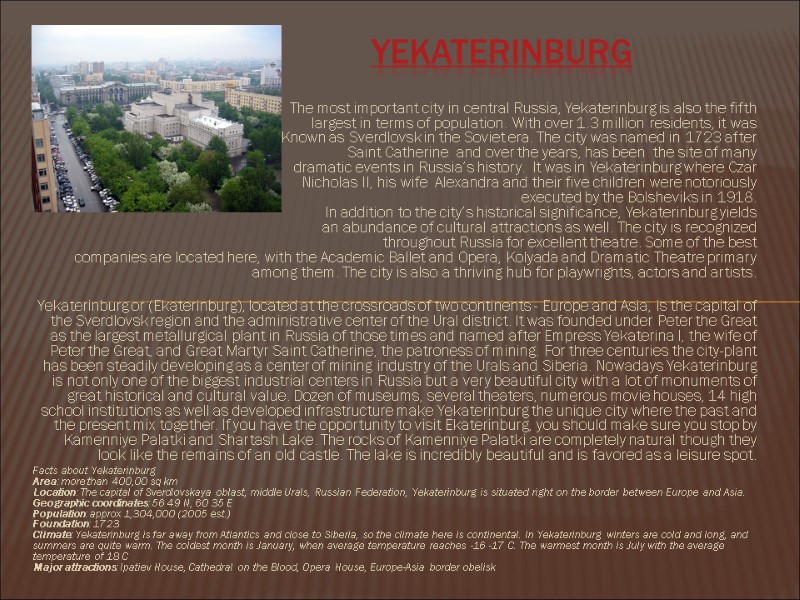
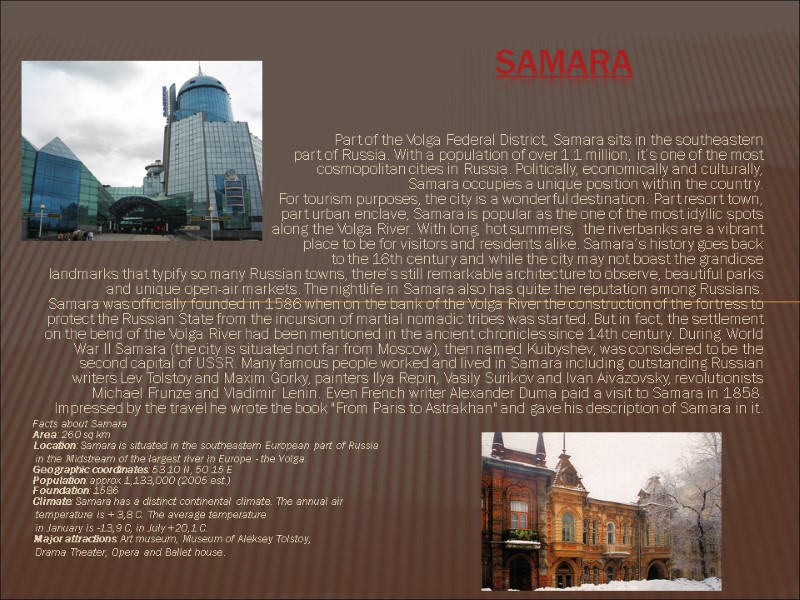
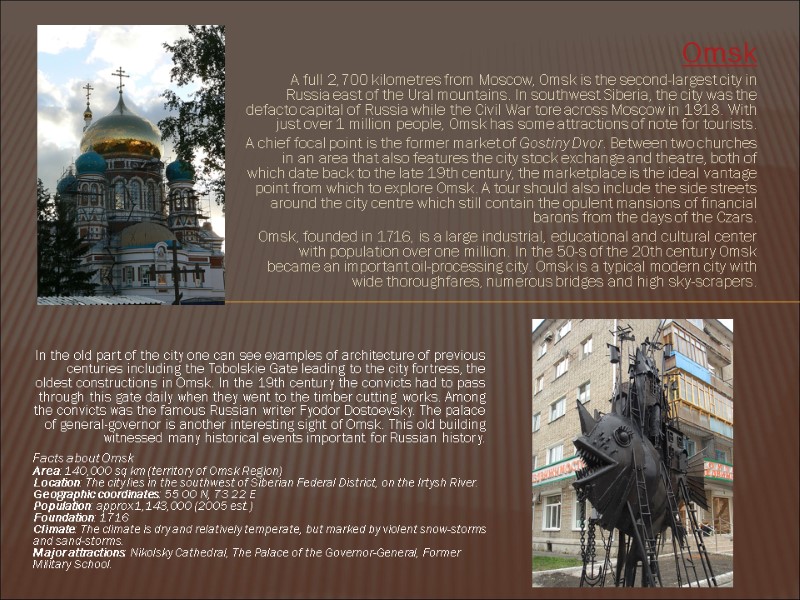
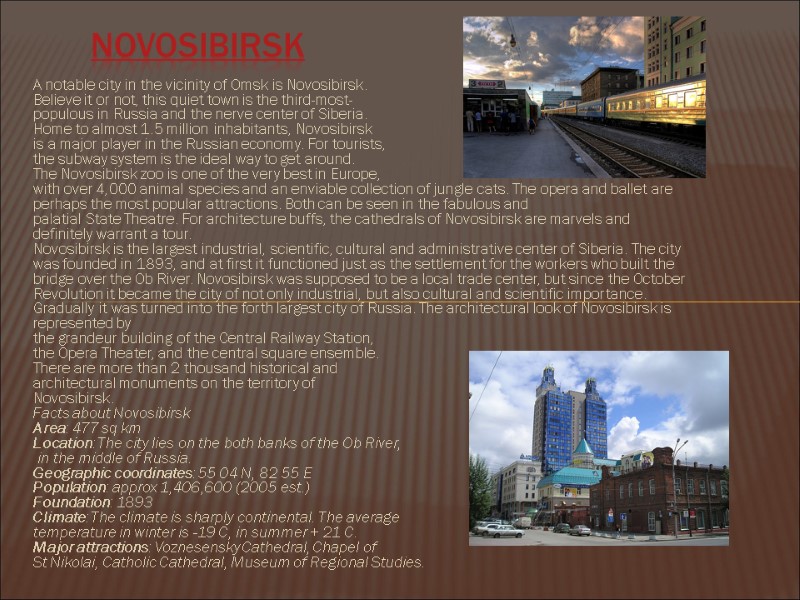
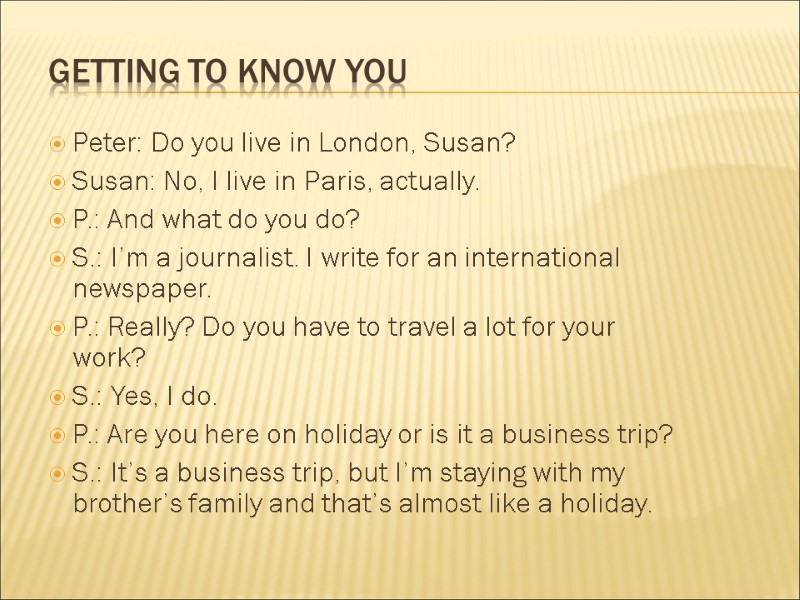
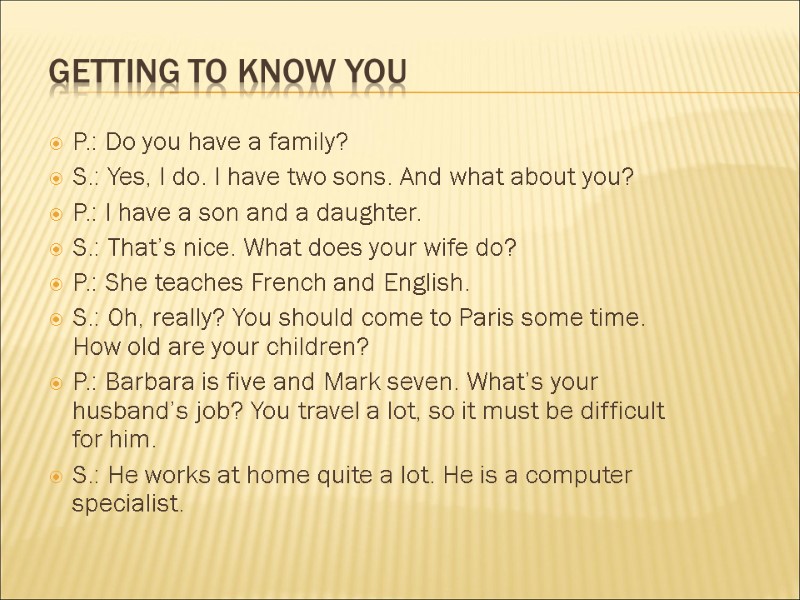

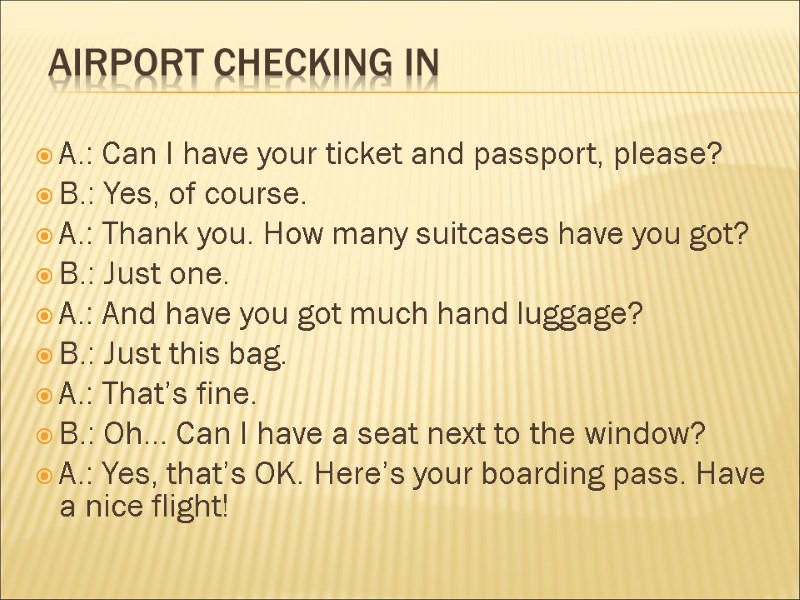
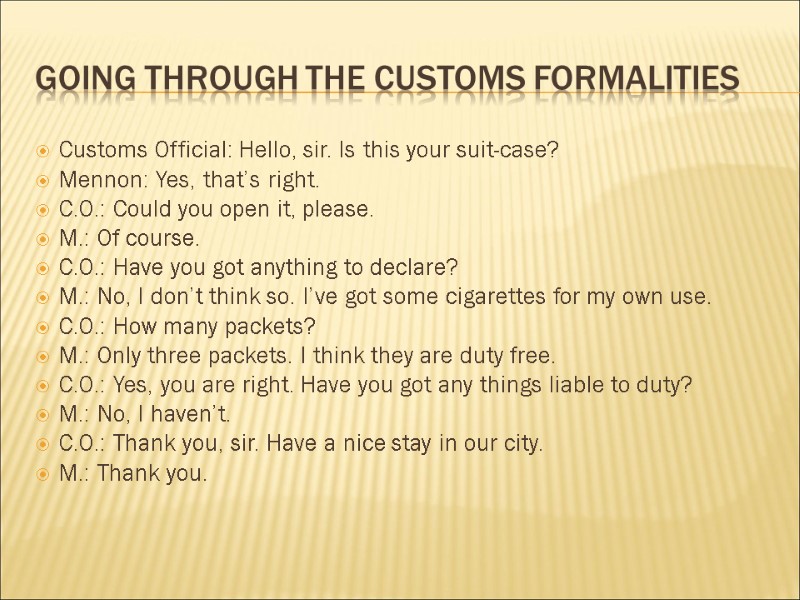
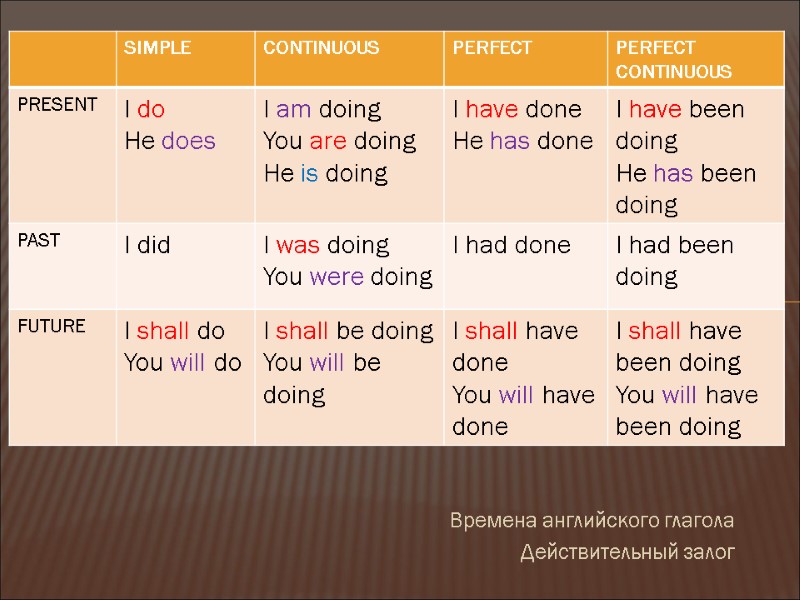
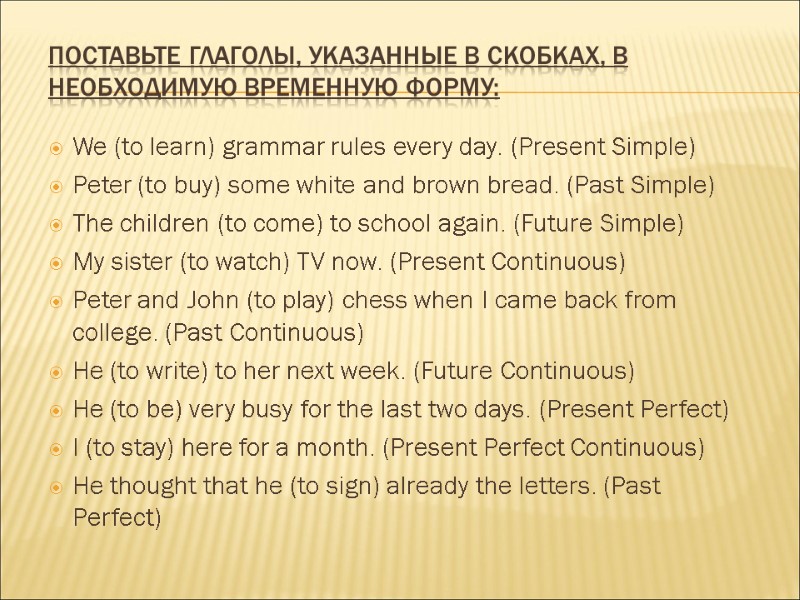
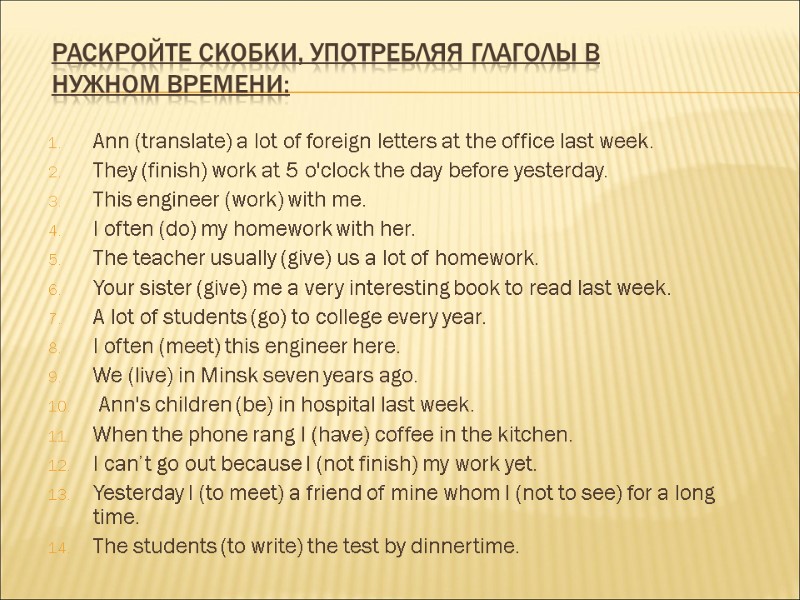
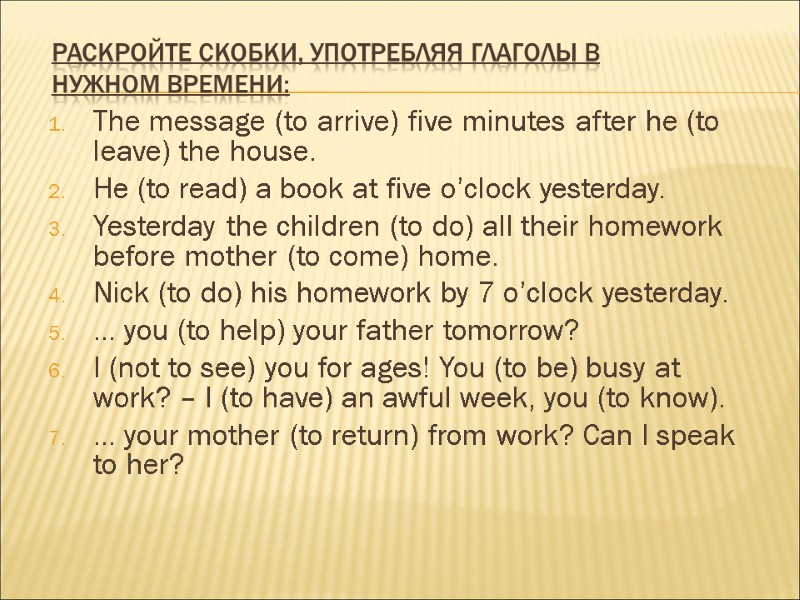
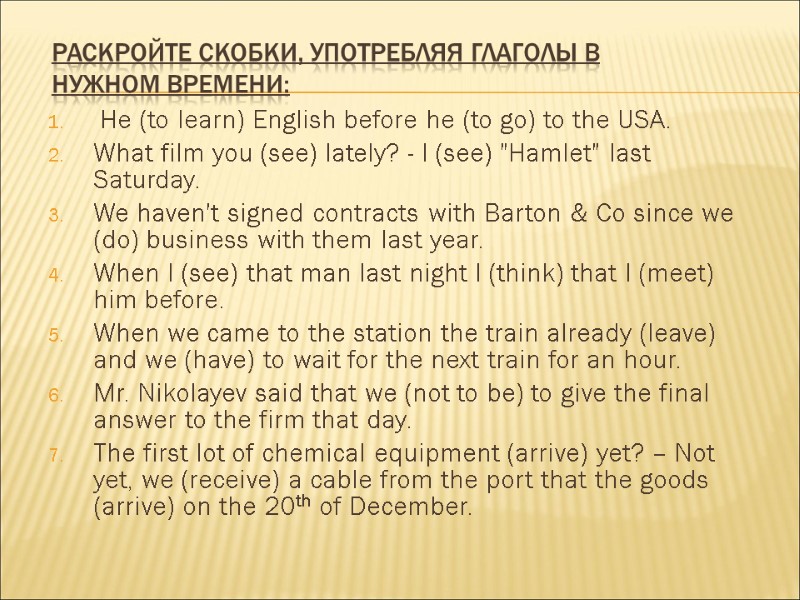
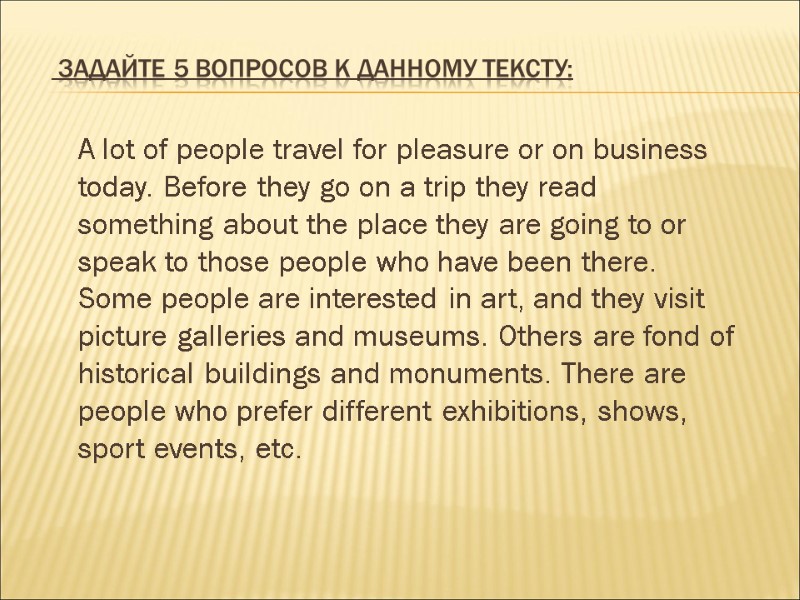
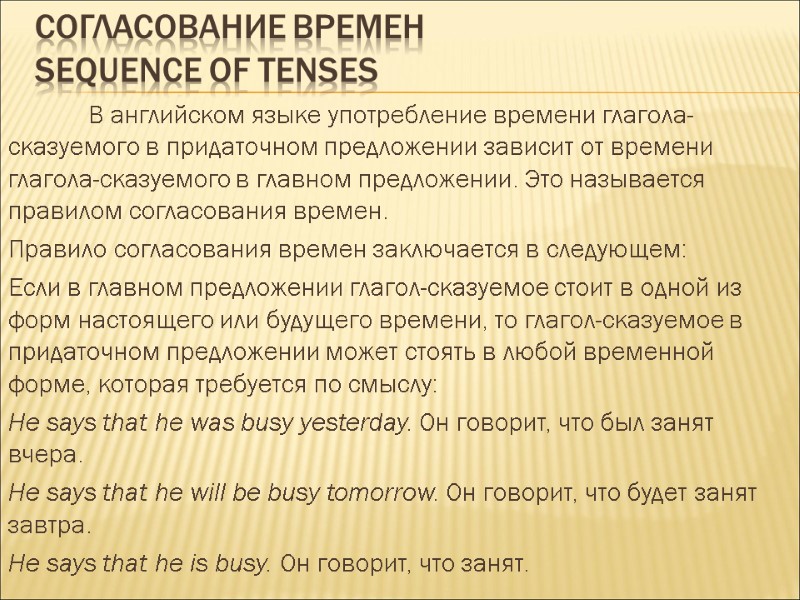
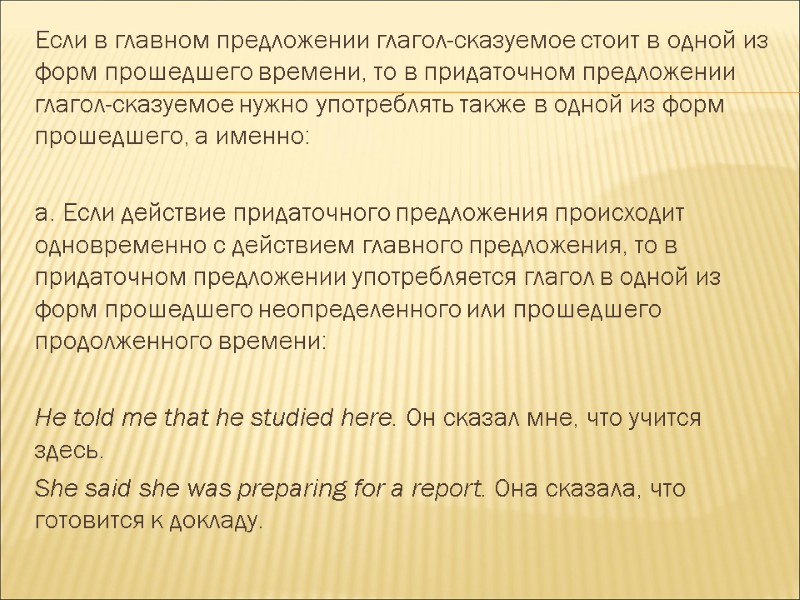
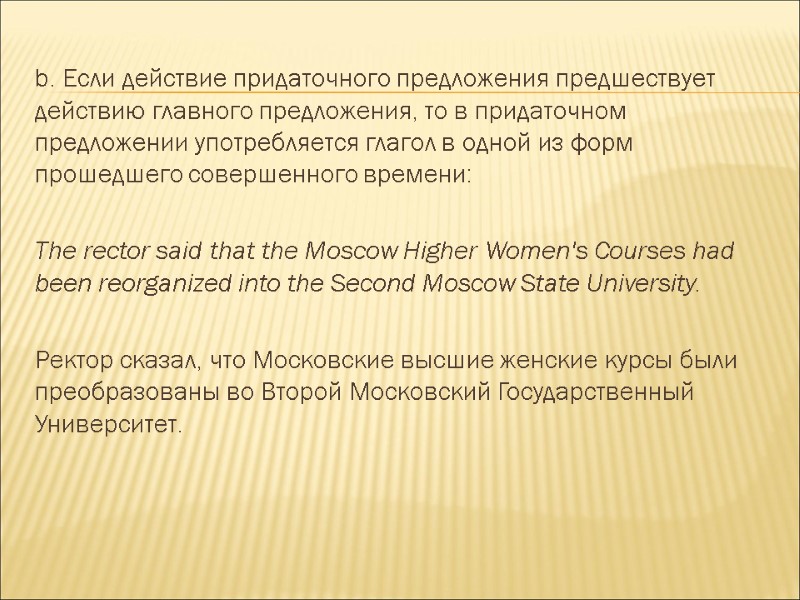
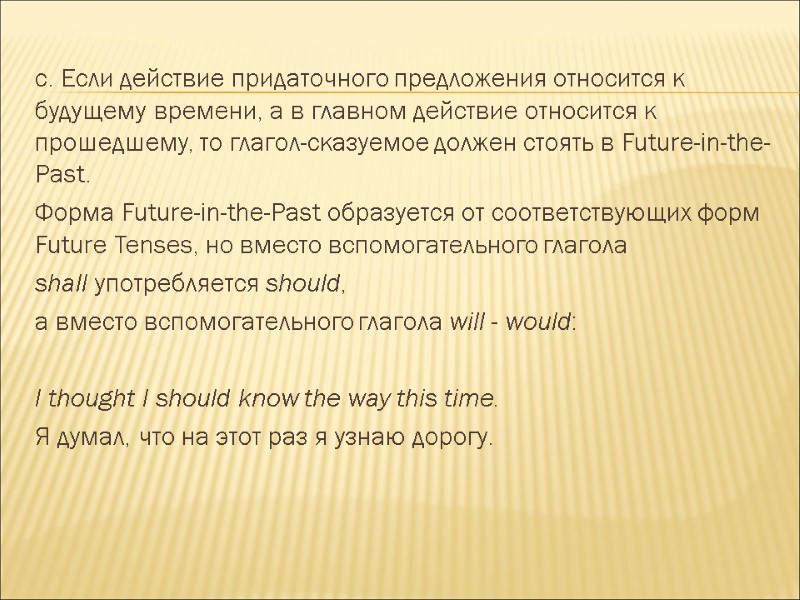
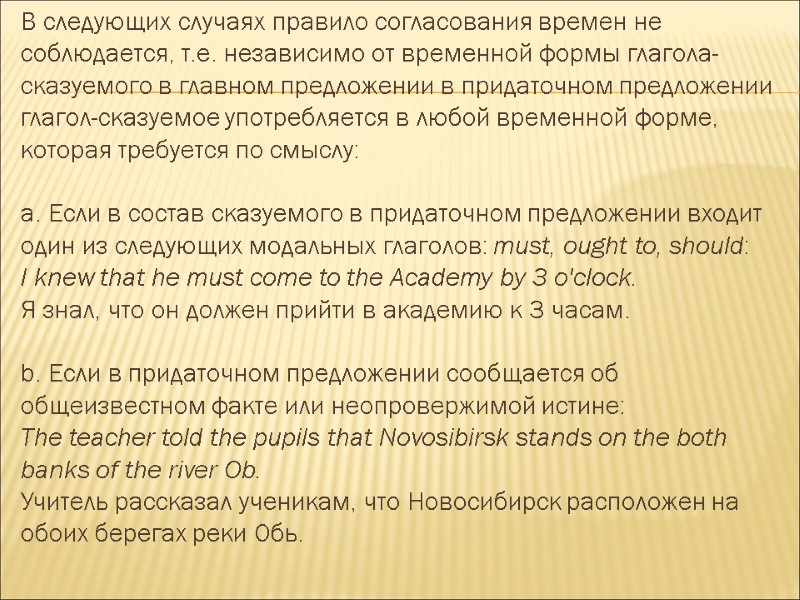
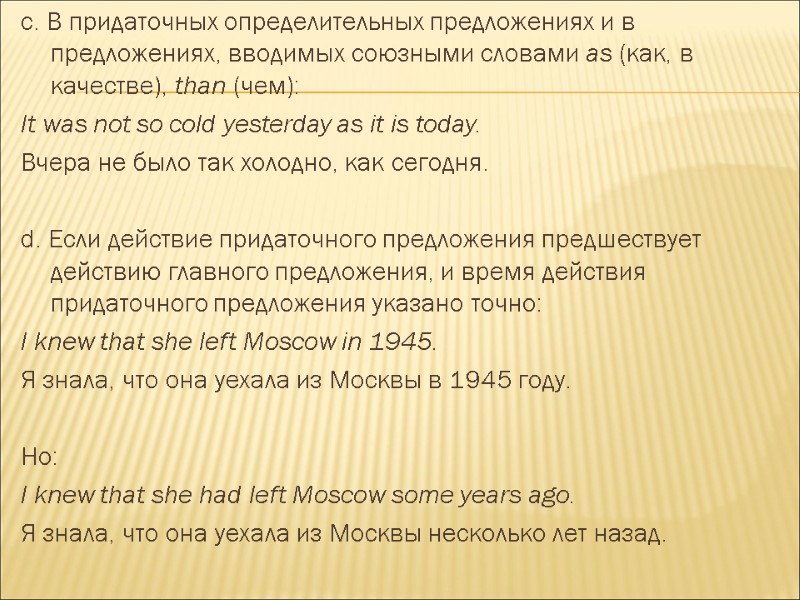
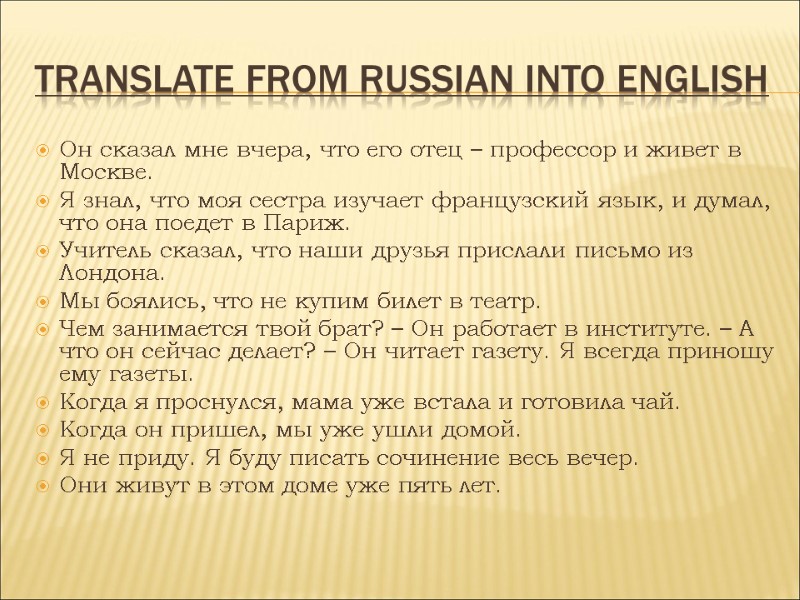
15876-unit_1_russia_1.ppt
- Количество слайдов: 49
 UNIT 1 THE RUSSIAN FEDERATION GREAT RUSSIAN CITIES Dialogues: Saying Hello Saying Goodbye Getting to know you Airport Checking in Going through Customs Formalities Grammar: ACTIVE VOICE SEQUENCE OF TENSES
UNIT 1 THE RUSSIAN FEDERATION GREAT RUSSIAN CITIES Dialogues: Saying Hello Saying Goodbye Getting to know you Airport Checking in Going through Customs Formalities Grammar: ACTIVE VOICE SEQUENCE OF TENSES
 The Russian federation FLAG COAT OF ARMS
The Russian federation FLAG COAT OF ARMS

 Russia, also officially known as the Russian Federation, is a state in northern Eurasia. It is a federal semi-presidential republic, comprising 83 federal subjects. From northwest to southeast, Russia shares borders with Norway, Finland, Estonia, Latvia, Lithuania and Poland (both via Kaliningrad Oblast), Belarus, Ukraine, Georgia, Azerbaijan, Kazakhstan, the People's Republic of China, Mongolia, and North Korea. It also has maritime borders with Japan by the Sea of Okhotsk and the United States by the Bering Strait. a federal semi-presidential republic - федеративная полупрезидентская (президентско-парламентская) республика to comprise - охватывать federal subject - федеральный субъект, субъект федерации via - через maritime borders - морские границы
Russia, also officially known as the Russian Federation, is a state in northern Eurasia. It is a federal semi-presidential republic, comprising 83 federal subjects. From northwest to southeast, Russia shares borders with Norway, Finland, Estonia, Latvia, Lithuania and Poland (both via Kaliningrad Oblast), Belarus, Ukraine, Georgia, Azerbaijan, Kazakhstan, the People's Republic of China, Mongolia, and North Korea. It also has maritime borders with Japan by the Sea of Okhotsk and the United States by the Bering Strait. a federal semi-presidential republic - федеративная полупрезидентская (президентско-парламентская) республика to comprise - охватывать federal subject - федеральный субъект, субъект федерации via - через maritime borders - морские границы
 At 17,075,400 sq. km, Russia is the largest country in the world, covering more than a ninth of the Earth's land area. Russia is also the ninth most populous nation with 142 million people. It extends across the whole of northern Asia and 40% of Europe, spanning 9 time zones and incorporating a wide range of environments and landforms. Russia has the world's largest reserves of mineral and energy resources. It has the world's largest forest reserves and its lakes contain approximately one-quarter of the world's fresh water. to span - простираться, охватывать time zone - часовой пояс to incorporate - объединять, включать landform - очертания суши, форма рельефа approximately - примерно, приблизительно fresh water - пресная вода
At 17,075,400 sq. km, Russia is the largest country in the world, covering more than a ninth of the Earth's land area. Russia is also the ninth most populous nation with 142 million people. It extends across the whole of northern Asia and 40% of Europe, spanning 9 time zones and incorporating a wide range of environments and landforms. Russia has the world's largest reserves of mineral and energy resources. It has the world's largest forest reserves and its lakes contain approximately one-quarter of the world's fresh water. to span - простираться, охватывать time zone - часовой пояс to incorporate - объединять, включать landform - очертания суши, форма рельефа approximately - примерно, приблизительно fresh water - пресная вода
 The nation's history began with that of the East Slavs, who emerged as a recognizable group in Europe between the 3rd and 8th centuries AD. Founded and ruled by a noble Viking warrior class and their descendants, the first East Slavic state, Kievan Rus', arose in the 9th century and adopted Orthodox Christianity from the Byzantine Empire in 988, beginning the synthesis of Byzantine and Slavic cultures that defined Russian culture for the next millennium. Kievan Rus' ultimately disintegrated and the lands were divided into many small feudal states. recognizable - могущий быть узнанным, признанный descendant - потомок to arise - возникать, появляться to adopt - принимать ultimately – в конечном счете, в конце концов to disintegrate – раздроблять(ся), распадаться feudal state – феодальное государство
The nation's history began with that of the East Slavs, who emerged as a recognizable group in Europe between the 3rd and 8th centuries AD. Founded and ruled by a noble Viking warrior class and their descendants, the first East Slavic state, Kievan Rus', arose in the 9th century and adopted Orthodox Christianity from the Byzantine Empire in 988, beginning the synthesis of Byzantine and Slavic cultures that defined Russian culture for the next millennium. Kievan Rus' ultimately disintegrated and the lands were divided into many small feudal states. recognizable - могущий быть узнанным, признанный descendant - потомок to arise - возникать, появляться to adopt - принимать ultimately – в конечном счете, в конце концов to disintegrate – раздроблять(ся), распадаться feudal state – феодальное государство
 The most powerful successor state to Kievan Rus' was Moscow, which served as the main force in the Russian reunification process and independence struggle against the Golden Horde. Moscow gradually reunified the surrounding Russian principalities and came to dominate the cultural and political legacy of Kievan Rus'. By the 18th century, the nation had greatly expanded through conquest, annexation, and exploration to become the Russian Empire, which was the third largest empire in history, stretching from Poland in Europe to Alaska in North America. successor – преемник, наследник reunification process – процесс воссоединения independence struggle – борьба за независимость the Golden Horde – Золотая Орда gradually - постепенно principality - княжество legacy – наследство, наследие to expand – расширяться, увеличиваться, распространяться conquest – завоевание, покорение annexation – присоединение, аннексия exploration - исследование
The most powerful successor state to Kievan Rus' was Moscow, which served as the main force in the Russian reunification process and independence struggle against the Golden Horde. Moscow gradually reunified the surrounding Russian principalities and came to dominate the cultural and political legacy of Kievan Rus'. By the 18th century, the nation had greatly expanded through conquest, annexation, and exploration to become the Russian Empire, which was the third largest empire in history, stretching from Poland in Europe to Alaska in North America. successor – преемник, наследник reunification process – процесс воссоединения independence struggle – борьба за независимость the Golden Horde – Золотая Орда gradually - постепенно principality - княжество legacy – наследство, наследие to expand – расширяться, увеличиваться, распространяться conquest – завоевание, покорение annexation – присоединение, аннексия exploration - исследование
 Russia established worldwide power and influence from the times of the Russian Empire being the largest and leading constituent of the Soviet Union, the world's first constitutionally socialist state and a recognized superpower, that played a decisive role in the Allied victory in World War II. The Soviet era saw some of the greatest technology achievements of the nation, such as the world's first human spaceflight. The Russian Federation was founded following the dissolution of the Soviet Union in 1991, but is recognized as the continuing legal personality of the Soviet state. worldwide power and influence – всемирное могущество и влияние constituent – составная часть recognized superpower – признанная супердержава decisive role – решающая роль spaceflight – космический полет dissolution – распад, исчезновение continuing legal personality – законный правопреемник
Russia established worldwide power and influence from the times of the Russian Empire being the largest and leading constituent of the Soviet Union, the world's first constitutionally socialist state and a recognized superpower, that played a decisive role in the Allied victory in World War II. The Soviet era saw some of the greatest technology achievements of the nation, such as the world's first human spaceflight. The Russian Federation was founded following the dissolution of the Soviet Union in 1991, but is recognized as the continuing legal personality of the Soviet state. worldwide power and influence – всемирное могущество и влияние constituent – составная часть recognized superpower – признанная супердержава decisive role – решающая роль spaceflight – космический полет dissolution – распад, исчезновение continuing legal personality – законный правопреемник
 Russia has the world's 12th largest economy by nominal GDP or the seventh largest by purchasing power parity, with the fifth largest nominal military budget. It is one of the five recognized nuclear weapons states and possesses the largest stockpile of weapons of mass destruction. nominal GDP (Gross Domestic Product) – номинальный ВВП (Валовой внутренний продукт) purchasing power parity – паритет покупательной способности nominal military budget – номинальный военный бюджет nuclear weapons state – ядерная держава stockpile of weapons of mass destruction – запас оружия массового поражения
Russia has the world's 12th largest economy by nominal GDP or the seventh largest by purchasing power parity, with the fifth largest nominal military budget. It is one of the five recognized nuclear weapons states and possesses the largest stockpile of weapons of mass destruction. nominal GDP (Gross Domestic Product) – номинальный ВВП (Валовой внутренний продукт) purchasing power parity – паритет покупательной способности nominal military budget – номинальный военный бюджет nuclear weapons state – ядерная держава stockpile of weapons of mass destruction – запас оружия массового поражения
 Russia is a great power and a permanent member of the United Nations Security Council, a member of the G8, G20, the Council of Europe, the Asia-Pacific Economic Cooperation, the Shanghai Cooperation Organization, the Eurasian Economic Community, the OSCE, and is the leading member of the Commonwealth of Independent States. the United Nations Security Council – Совет безопасности Организации объединенных наций the G8 – Большая восьмерка the G20 – Большая двадцатка the Council of Europe – Совет Европы the Asia-Pacific Economic Cooperation - Азиатско-Тихоокеанское экономическое сотрудничество the Shanghai Cooperation Organization – Шанхайская организация сотрудничества the Eurasian Economic Community – Евроазиатское экономическое сообщество the OSCE (The Organization for Security and Cooperation in Europe) – ОБСЕ (Организация по безопасности и сотрудничеству в Европе) the Commonwealth of Independent States – СНГ (Содружество независимых государств)
Russia is a great power and a permanent member of the United Nations Security Council, a member of the G8, G20, the Council of Europe, the Asia-Pacific Economic Cooperation, the Shanghai Cooperation Organization, the Eurasian Economic Community, the OSCE, and is the leading member of the Commonwealth of Independent States. the United Nations Security Council – Совет безопасности Организации объединенных наций the G8 – Большая восьмерка the G20 – Большая двадцатка the Council of Europe – Совет Европы the Asia-Pacific Economic Cooperation - Азиатско-Тихоокеанское экономическое сотрудничество the Shanghai Cooperation Organization – Шанхайская организация сотрудничества the Eurasian Economic Community – Евроазиатское экономическое сообщество the OSCE (The Organization for Security and Cooperation in Europe) – ОБСЕ (Организация по безопасности и сотрудничеству в Европе) the Commonwealth of Independent States – СНГ (Содружество независимых государств)
 Etymology The country's original name was Русь (Rus'), a medieval state populated mostly by the East Slavs. However, this proper name became more prominent in the later history, and the country typically was called by its inhabitants "Русская Земля" (russkaya zemlya) which could be translated as "Russian Land" or "Land of Rus'". In order to distinguish this state from other states derived from it, it is denoted as Kievan Rus' by modern historiography. An old Latin version of the name Rus' was Ruthenia, mostly applied to the western and southern regions of Rus' that were adjacent to Catholic Europe. The current name of the country, Россия (Rossiya), comes from the Greek version of Rus', spelled Ρωσία [rosˈia], which was the denomination of Kievan Rus in the Byzantine Empire. etymology – этимология, происхождение medieval state- средневековое государство prominent – известный, видный, выдающийся inhabitants – жители, население to distinguish - различать to derive – происходить, наследовать to denote – обозначать, означать historiography - историография adjacent – прилегающий, смежный, соседний
Etymology The country's original name was Русь (Rus'), a medieval state populated mostly by the East Slavs. However, this proper name became more prominent in the later history, and the country typically was called by its inhabitants "Русская Земля" (russkaya zemlya) which could be translated as "Russian Land" or "Land of Rus'". In order to distinguish this state from other states derived from it, it is denoted as Kievan Rus' by modern historiography. An old Latin version of the name Rus' was Ruthenia, mostly applied to the western and southern regions of Rus' that were adjacent to Catholic Europe. The current name of the country, Россия (Rossiya), comes from the Greek version of Rus', spelled Ρωσία [rosˈia], which was the denomination of Kievan Rus in the Byzantine Empire. etymology – этимология, происхождение medieval state- средневековое государство prominent – известный, видный, выдающийся inhabitants – жители, население to distinguish - различать to derive – происходить, наследовать to denote – обозначать, означать historiography - историография adjacent – прилегающий, смежный, соседний
 Geography Russia is the largest country in the world; its total area is 17,075,400 square kilometres. There are 23 UNESCO World Heritage Sites in Russia, 40 UNESCO biosphere reserves, 40 national parks and 101 nature reserves. Russia has a wide natural resource base, including major deposits of timber, petroleum, natural gas, coal, ores and other mineral resources.
Geography Russia is the largest country in the world; its total area is 17,075,400 square kilometres. There are 23 UNESCO World Heritage Sites in Russia, 40 UNESCO biosphere reserves, 40 national parks and 101 nature reserves. Russia has a wide natural resource base, including major deposits of timber, petroleum, natural gas, coal, ores and other mineral resources.
 Most of Russia consists of vast stretches of plains that are predominantly steppe to the south and heavily forested to the north, with tundra along the northern coast. Russia possesses 10% of the world's arable land. Mountain ranges are found along the southern borders, such as the Caucasus (containing Mount Elbrus, which at 5,642 m is the highest point in both Russia and Europe) and the Altai (containing Mount Belukha, which at the 4,506 m is the highest point of Asian Russia); and in the eastern parts, such as the Verkhoyansk Range or the volcanoes on Kamchatka. The Ural Mountains, rich in mineral resources, form a north-south range that divides Europe and Asia.
Most of Russia consists of vast stretches of plains that are predominantly steppe to the south and heavily forested to the north, with tundra along the northern coast. Russia possesses 10% of the world's arable land. Mountain ranges are found along the southern borders, such as the Caucasus (containing Mount Elbrus, which at 5,642 m is the highest point in both Russia and Europe) and the Altai (containing Mount Belukha, which at the 4,506 m is the highest point of Asian Russia); and in the eastern parts, such as the Verkhoyansk Range or the volcanoes on Kamchatka. The Ural Mountains, rich in mineral resources, form a north-south range that divides Europe and Asia.
 Russia has an extensive coastline of over 37,000 km along the Arctic and Pacific Oceans, as well as along the Baltic Sea, Sea of Azov, Black Sea and Caspian Sea. The Barents Sea, White Sea, Kara Sea, Laptev Sea, East Siberian Sea, Chukchi Sea, Bering Sea, Sea of Okhotsk, and the Sea of Japan are linked to Russia via the Arctic and Pacific. Russia's major islands and archipelagos include Novaya Zemlya, the Franz Josef Land, the Severnaya Zemlya, the New Siberian Islands, Wrangel Island, the Kuril Islands, and Sakhalin. The Diomede Islands (one controlled by Russia, the other by the United States) are just 3 km apart, and Kunashir Island is about 20 km from Hokkaidō, Japan.
Russia has an extensive coastline of over 37,000 km along the Arctic and Pacific Oceans, as well as along the Baltic Sea, Sea of Azov, Black Sea and Caspian Sea. The Barents Sea, White Sea, Kara Sea, Laptev Sea, East Siberian Sea, Chukchi Sea, Bering Sea, Sea of Okhotsk, and the Sea of Japan are linked to Russia via the Arctic and Pacific. Russia's major islands and archipelagos include Novaya Zemlya, the Franz Josef Land, the Severnaya Zemlya, the New Siberian Islands, Wrangel Island, the Kuril Islands, and Sakhalin. The Diomede Islands (one controlled by Russia, the other by the United States) are just 3 km apart, and Kunashir Island is about 20 km from Hokkaidō, Japan.
 Russia has thousands of rivers and inland bodies of water providing it with one of the world’s largest surface water resources. The largest and most prominent of Russia's bodies of fresh water is Lake Baikal, the world's deepest, purest, oldest and most capacious freshwater lake. Baikal alone contains over one fifth of the world's fresh surface water. Other major lakes include Lake Ladoga and Lake Onega, two of the largest lakes in Europe. Russia is second only to Brazil in volume of the total renewable water resources. Of the country's 100,000 rivers, the Volga is the most famous, not only because it is the longest river in Europe, but also because of its major role in Russian history.
Russia has thousands of rivers and inland bodies of water providing it with one of the world’s largest surface water resources. The largest and most prominent of Russia's bodies of fresh water is Lake Baikal, the world's deepest, purest, oldest and most capacious freshwater lake. Baikal alone contains over one fifth of the world's fresh surface water. Other major lakes include Lake Ladoga and Lake Onega, two of the largest lakes in Europe. Russia is second only to Brazil in volume of the total renewable water resources. Of the country's 100,000 rivers, the Volga is the most famous, not only because it is the longest river in Europe, but also because of its major role in Russian history.
 According to the Constitution of Russia, the country is a federation and semi-presidential republic, wherein the President is the head of state and the Prime Minister is the head of government. The Russian Federation is fundamentally structured as a representative democracy, with the federal government composed of three branches: Legislative Executive Judicial
According to the Constitution of Russia, the country is a federation and semi-presidential republic, wherein the President is the head of state and the Prime Minister is the head of government. The Russian Federation is fundamentally structured as a representative democracy, with the federal government composed of three branches: Legislative Executive Judicial
 Legislative brunch: The bicameral Federal Assembly, made up of the 450-member State Duma and the 176-member Federation Council, adopts federal law, declares war, approves treaties, has the power of the purse, and has power of impeachment of the President. Executive brunch: The President is the commander-in-chief of the military, can veto legislative bills before they become law, and appoints the Cabinet and other officers, who administer and enforce federal laws and policies. Judicial brunch: The Constitutional Court, Supreme Court, Supreme Court of Arbitration and lower federal courts, whose judges are appointed by the Federation Council on the recommendation of the President, interpret laws and can overturn laws they deem unconstitutional.
Legislative brunch: The bicameral Federal Assembly, made up of the 450-member State Duma and the 176-member Federation Council, adopts federal law, declares war, approves treaties, has the power of the purse, and has power of impeachment of the President. Executive brunch: The President is the commander-in-chief of the military, can veto legislative bills before they become law, and appoints the Cabinet and other officers, who administer and enforce federal laws and policies. Judicial brunch: The Constitutional Court, Supreme Court, Supreme Court of Arbitration and lower federal courts, whose judges are appointed by the Federation Council on the recommendation of the President, interpret laws and can overturn laws they deem unconstitutional.

 The Russian Federation comprises 83 federal subjects. These subjects have equal representation — two delegates each — in the Federation Council. However, they differ in the degree of autonomy they enjoy. 46 oblasts (provinces): most common type of federal subjects, with federally appointed governor and locally elected legislature. 21 republics: nominally autonomous; each has its own constitution, president, and parliament. Republics are allowed to establish their own official language alongside Russian but are represented by the federal government in international affairs. Republics are meant to be home to specific ethnic minorities. 9 krais (territories): essentially the same as oblasts. The "territory" designation is historic, originally given to frontier regions and later also to administrative divisions that comprised autonomous okrugs or autonomous oblasts.
The Russian Federation comprises 83 federal subjects. These subjects have equal representation — two delegates each — in the Federation Council. However, they differ in the degree of autonomy they enjoy. 46 oblasts (provinces): most common type of federal subjects, with federally appointed governor and locally elected legislature. 21 republics: nominally autonomous; each has its own constitution, president, and parliament. Republics are allowed to establish their own official language alongside Russian but are represented by the federal government in international affairs. Republics are meant to be home to specific ethnic minorities. 9 krais (territories): essentially the same as oblasts. The "territory" designation is historic, originally given to frontier regions and later also to administrative divisions that comprised autonomous okrugs or autonomous oblasts.
 4 autonomous okrugs (autonomous districts): originally autonomous entities within oblasts and krais created for ethnic minorities, their status was elevated to that of federal subjects in the 1990s. With the exception of Chukotka Autonomous Okrug, all autonomous okrugs are still administratively subordinated to a krai or an oblast of which they are a part. 1 autonomous oblast (the Jewish Autonomous Oblast): originally autonomous oblasts were administrative units subordinated to krais. In 1990, all of them except the Jewish AO were elevated in status to that of a republic. 2 federal cities (Moscow and St. Petersburg): major cities that function as separate regions.
4 autonomous okrugs (autonomous districts): originally autonomous entities within oblasts and krais created for ethnic minorities, their status was elevated to that of federal subjects in the 1990s. With the exception of Chukotka Autonomous Okrug, all autonomous okrugs are still administratively subordinated to a krai or an oblast of which they are a part. 1 autonomous oblast (the Jewish Autonomous Oblast): originally autonomous oblasts were administrative units subordinated to krais. In 1990, all of them except the Jewish AO were elevated in status to that of a republic. 2 federal cities (Moscow and St. Petersburg): major cities that function as separate regions.
 Moscow, the capital of Russia is located on the river Moskva in the western region of Russia. Russian contrasts are more present here than in any other city in Russia. Ancient monasteries and ultra-modern monoliths stand side by side and the new Russian millionaires and the poor pensioners walk side by side in the same streets. The Kremlin, broads and glitters in the heart of Moscow. It thrills and tantalizes whenever you see its towers against the skyline or its cathedrals and palaces arrayed above the Moskva River. Facts about Moscow Area: over 1,091 sq km Location: European part of Russian Federation, between the Oka and the Volga Rivers, on the Moskva River. Geographic coordinates: 55 45 N, 37 37 E Population: approx 10,407,000 (2005 est.) Foundation: 1147, by Duke Yuri Dolgorukiy Climate: The climate varies from intensely cold winters to swelteringly hot summers. Major attractions: Kremlin, Red Square, St. Basil's Cathedral, Poklonnaya Mountain, Cathedral of Christ the Savior. Moscow
Moscow, the capital of Russia is located on the river Moskva in the western region of Russia. Russian contrasts are more present here than in any other city in Russia. Ancient monasteries and ultra-modern monoliths stand side by side and the new Russian millionaires and the poor pensioners walk side by side in the same streets. The Kremlin, broads and glitters in the heart of Moscow. It thrills and tantalizes whenever you see its towers against the skyline or its cathedrals and palaces arrayed above the Moskva River. Facts about Moscow Area: over 1,091 sq km Location: European part of Russian Federation, between the Oka and the Volga Rivers, on the Moskva River. Geographic coordinates: 55 45 N, 37 37 E Population: approx 10,407,000 (2005 est.) Foundation: 1147, by Duke Yuri Dolgorukiy Climate: The climate varies from intensely cold winters to swelteringly hot summers. Major attractions: Kremlin, Red Square, St. Basil's Cathedral, Poklonnaya Mountain, Cathedral of Christ the Savior. Moscow
 The Kremlin, broads and glitters in the heart of Moscow. It thrills and tantalizes whenever you see its towers against the skyline or its cathedrals and palaces arrayed above the Moskva River. The Kremlin is surrounded by a beautiful residential district that is known as the Bely Gorod or the White Town. The Bely Gorod was the very heart of the city during the sixteenth century, and even today it has a strongly medieval feel. Moscow is also well known as the site of the Saint Basil's Cathedral, with its elegant onion domes. The Patriarch of Moscow, whose residence is the Danilov Monastery, serves as the head of the Russian Orthodox Church.
The Kremlin, broads and glitters in the heart of Moscow. It thrills and tantalizes whenever you see its towers against the skyline or its cathedrals and palaces arrayed above the Moskva River. The Kremlin is surrounded by a beautiful residential district that is known as the Bely Gorod or the White Town. The Bely Gorod was the very heart of the city during the sixteenth century, and even today it has a strongly medieval feel. Moscow is also well known as the site of the Saint Basil's Cathedral, with its elegant onion domes. The Patriarch of Moscow, whose residence is the Danilov Monastery, serves as the head of the Russian Orthodox Church.
 Red Square – Russia's Glorious Heritage Not only is the Red Square a popular Moscow attraction, but is flanked by world known sites and tourist attractions. Contrary to popular belief, Red Square received its name through the Russian word for “red”, which centuries ago meant “beautiful”, and not due to a communist symbol or the red Kremlin walls. Red Square came into being during the reign of Ivan III at the end of the 15th century. Named after the Trinity Cathedral, the Red Square was formerly known as Trinity Square, and is believed to only have had the name change at the end of the 17th century. St Basil’s Cathedral is now located in the site where Trinity Cathedral once stood. St Basil’s Cathedral is situated along side the eastern wall of the Kremlin, with its spiralling bright coloured onion domes. Also located around the Red Sqaure, is the Kazan Cathedral, Russia’s National Museum, the GUM department store and the 1990 replica of the Resurrection Gate. During the reign of Peter the Great and Ivan the Terrible, the Red Square was used for public executions, and on the Red Square platform named Lobnoye Mesto, the Tsar would some times address the people.
Red Square – Russia's Glorious Heritage Not only is the Red Square a popular Moscow attraction, but is flanked by world known sites and tourist attractions. Contrary to popular belief, Red Square received its name through the Russian word for “red”, which centuries ago meant “beautiful”, and not due to a communist symbol or the red Kremlin walls. Red Square came into being during the reign of Ivan III at the end of the 15th century. Named after the Trinity Cathedral, the Red Square was formerly known as Trinity Square, and is believed to only have had the name change at the end of the 17th century. St Basil’s Cathedral is now located in the site where Trinity Cathedral once stood. St Basil’s Cathedral is situated along side the eastern wall of the Kremlin, with its spiralling bright coloured onion domes. Also located around the Red Sqaure, is the Kazan Cathedral, Russia’s National Museum, the GUM department store and the 1990 replica of the Resurrection Gate. During the reign of Peter the Great and Ivan the Terrible, the Red Square was used for public executions, and on the Red Square platform named Lobnoye Mesto, the Tsar would some times address the people.
 When Peter the Great moved to St Petersburg in 1712, the Red Square became dormant as Moscow was no longer the Russian capital. The new communist regime, the Bolsheviks, moved the capital back to Moscow in 1918, and turned the Red Square into a parade ground and memorial cemetery. The Lenin Mausoleum was built in 1924, where the embalmed body of the communist founder was laid to rest. The new communist regime was focused on the goals on the Soviet, and saw no space for the historical Kazan Cathedral or the Iverskaya Chapel with the Resurrection Gates, and destroyed these buildings to make space for demonstrations and military parades. The GUM Department Store and Historical Museum were also in line for destruction, but the outbreak of World War II saved the buildings, as attention was diverted the war effort.
When Peter the Great moved to St Petersburg in 1712, the Red Square became dormant as Moscow was no longer the Russian capital. The new communist regime, the Bolsheviks, moved the capital back to Moscow in 1918, and turned the Red Square into a parade ground and memorial cemetery. The Lenin Mausoleum was built in 1924, where the embalmed body of the communist founder was laid to rest. The new communist regime was focused on the goals on the Soviet, and saw no space for the historical Kazan Cathedral or the Iverskaya Chapel with the Resurrection Gates, and destroyed these buildings to make space for demonstrations and military parades. The GUM Department Store and Historical Museum were also in line for destruction, but the outbreak of World War II saved the buildings, as attention was diverted the war effort.
 The Red Square was home to many military parades but most significant was the parade on 7 November 1941. Nazi troops were advancing on the Moscow capital, and the Russian soldiers paraded on the square and marched off to lines to defend the capital. This action lifted the spirit of the Soviet people and renewed their confidence in the war. Hundreds of Soviet troops again filled the square in June 1945, but this time it was to celebrate their victory over the Nazis and German banners were thrown down in front of Lenin’s Mausoleum. The Red Square is surrounded by history and beauty, which provides education and endless attractions for the visitor.
The Red Square was home to many military parades but most significant was the parade on 7 November 1941. Nazi troops were advancing on the Moscow capital, and the Russian soldiers paraded on the square and marched off to lines to defend the capital. This action lifted the spirit of the Soviet people and renewed their confidence in the war. Hundreds of Soviet troops again filled the square in June 1945, but this time it was to celebrate their victory over the Nazis and German banners were thrown down in front of Lenin’s Mausoleum. The Red Square is surrounded by history and beauty, which provides education and endless attractions for the visitor.
 Saint Petersburg is a very young city compared to old European capitals and, probably, the only city in the world that has acquired so much historic significance in such a short time. It was founded in 1703 as an outlet to the sea, which was very important for Russia's future development from both strategic and economical points of view. Facts about St.Petersburg Area: 606 sq km Location: Located at the mouth of the Neva River and across the islands of its delta on the coast of the Finnish Gulf. Geographic coordinates: 59 55 N, 30 25 E Population: approx 4,600,000 (2005 est.) Foundation: May 1703, by Peter the Great Climate: The climate is intermediate (from nautical to continental). The average temperature in July is +18 C, in February -8 C. Major attractions: Hermitage, Winter Palace, St Isaac Cathedral, Savior on the Blood, Alexander Nevsky Lavra. Saint Petersburg
Saint Petersburg is a very young city compared to old European capitals and, probably, the only city in the world that has acquired so much historic significance in such a short time. It was founded in 1703 as an outlet to the sea, which was very important for Russia's future development from both strategic and economical points of view. Facts about St.Petersburg Area: 606 sq km Location: Located at the mouth of the Neva River and across the islands of its delta on the coast of the Finnish Gulf. Geographic coordinates: 59 55 N, 30 25 E Population: approx 4,600,000 (2005 est.) Foundation: May 1703, by Peter the Great Climate: The climate is intermediate (from nautical to continental). The average temperature in July is +18 C, in February -8 C. Major attractions: Hermitage, Winter Palace, St Isaac Cathedral, Savior on the Blood, Alexander Nevsky Lavra. Saint Petersburg
 Saint Petersburg was considered to be "a key for paradise" for the Russian Empire, so the city's name is very symbolic: it was called in honor of Saint Peter, who, as we know from the Holy Bible, was a keeper of the keys from the paradise. Saint Petersburg today is one of the most important cultural, scientific and industrial cities in Russia, housing several hundred of museums and exhibition halls. Great Russian and foreign artists, poets, writers and composers admired the beauty of Saint Petersburg and commemorated it in their works.
Saint Petersburg was considered to be "a key for paradise" for the Russian Empire, so the city's name is very symbolic: it was called in honor of Saint Peter, who, as we know from the Holy Bible, was a keeper of the keys from the paradise. Saint Petersburg today is one of the most important cultural, scientific and industrial cities in Russia, housing several hundred of museums and exhibition halls. Great Russian and foreign artists, poets, writers and composers admired the beauty of Saint Petersburg and commemorated it in their works.
 The most important city in central Russia, Yekaterinburg is also the fifth largest in terms of population. With over 1.3 million residents, it was Known as Sverdlovsk in the Soviet era. The city was named in 1723 after Saint Catherine and over the years, has been the site of many dramatic events in Russia’s history. It was in Yekaterinburg where Czar Nicholas II, his wife Alexandra and their five children were notoriously executed by the Bolsheviks in 1918. In addition to the city’s historical significance, Yekaterinburg yields an abundance of cultural attractions as well. The city is recognized throughout Russia for excellent theatre. Some of the best companies are located here, with the Academic Ballet and Opera, Kolyada and Dramatic Theatre primary among them. The city is also a thriving hub for playwrights, actors and artists. Yekaterinburg or (Ekaterinburg), located at the crossroads of two continents - Europe and Asia, is the capital of the Sverdlovsk region and the administrative center of the Ural district. It was founded under Peter the Great as the largest metallurgical plant in Russia of those times and named after Empress Yekaterina I, the wife of Peter the Great, and Great Martyr Saint Catherine, the patroness of mining. For three centuries the city-plant has been steadily developing as a center of mining industry of the Urals and Siberia. Nowadays Yekaterinburg is not only one of the biggest industrial centers in Russia but a very beautiful city with a lot of monuments of great historical and cultural value. Dozen of museums, several theaters, numerous movie houses, 14 high school institutions as well as developed infrastructure make Yekaterinburg the unique city where the past and the present mix together. If you have the opportunity to visit Ekaterinburg, you should make sure you stop by Kamenniye Palatki and Shartash Lake. The rocks of Kamenniye Palatki are completely natural though they look like the remains of an old castle. The lake is incredibly beautiful and is favored as a leisure spot. Facts about Yekaterinburg Area: more than 400,00 sq km Location: The capital of Sverdlovskaya oblast, middle Urals, Russian Federation, Yekaterinburg is situated right on the border between Europe and Asia. Geographic coordinates: 56 49 N, 60 35 E Population: approx 1,304,000 (2005 est.) Foundation: 1723 Climate: Yekaterinburg is far away from Atlantics and close to Siberia, so the climate here is continental. In Yekaterinburg winters are cold and long, and summers are quite warm. The coldest month is January, when average temperature reaches -16 -17 C. The warmest month is July with the average temperature of 18 C Major attractions: Ipatiev House, Cathedral on the Blood, Opera House, Europe-Asia border obelisk Yekaterinburg
The most important city in central Russia, Yekaterinburg is also the fifth largest in terms of population. With over 1.3 million residents, it was Known as Sverdlovsk in the Soviet era. The city was named in 1723 after Saint Catherine and over the years, has been the site of many dramatic events in Russia’s history. It was in Yekaterinburg where Czar Nicholas II, his wife Alexandra and their five children were notoriously executed by the Bolsheviks in 1918. In addition to the city’s historical significance, Yekaterinburg yields an abundance of cultural attractions as well. The city is recognized throughout Russia for excellent theatre. Some of the best companies are located here, with the Academic Ballet and Opera, Kolyada and Dramatic Theatre primary among them. The city is also a thriving hub for playwrights, actors and artists. Yekaterinburg or (Ekaterinburg), located at the crossroads of two continents - Europe and Asia, is the capital of the Sverdlovsk region and the administrative center of the Ural district. It was founded under Peter the Great as the largest metallurgical plant in Russia of those times and named after Empress Yekaterina I, the wife of Peter the Great, and Great Martyr Saint Catherine, the patroness of mining. For three centuries the city-plant has been steadily developing as a center of mining industry of the Urals and Siberia. Nowadays Yekaterinburg is not only one of the biggest industrial centers in Russia but a very beautiful city with a lot of monuments of great historical and cultural value. Dozen of museums, several theaters, numerous movie houses, 14 high school institutions as well as developed infrastructure make Yekaterinburg the unique city where the past and the present mix together. If you have the opportunity to visit Ekaterinburg, you should make sure you stop by Kamenniye Palatki and Shartash Lake. The rocks of Kamenniye Palatki are completely natural though they look like the remains of an old castle. The lake is incredibly beautiful and is favored as a leisure spot. Facts about Yekaterinburg Area: more than 400,00 sq km Location: The capital of Sverdlovskaya oblast, middle Urals, Russian Federation, Yekaterinburg is situated right on the border between Europe and Asia. Geographic coordinates: 56 49 N, 60 35 E Population: approx 1,304,000 (2005 est.) Foundation: 1723 Climate: Yekaterinburg is far away from Atlantics and close to Siberia, so the climate here is continental. In Yekaterinburg winters are cold and long, and summers are quite warm. The coldest month is January, when average temperature reaches -16 -17 C. The warmest month is July with the average temperature of 18 C Major attractions: Ipatiev House, Cathedral on the Blood, Opera House, Europe-Asia border obelisk Yekaterinburg
 Part of the Volga Federal District, Samara sits in the southeastern part of Russia. With a population of over 1.1 million, it’s one of the most cosmopolitan cities in Russia. Politically, economically and culturally, Samara occupies a unique position within the country. For tourism purposes, the city is a wonderful destination. Part resort town, part urban enclave, Samara is popular as the one of the most idyllic spots along the Volga River. With long, hot summers, the riverbanks are a vibrant place to be for visitors and residents alike. Samara’s history goes back to the 16th century and while the city may not boast the grandiose landmarks that typify so many Russian towns, there’s still remarkable architecture to observe, beautiful parks and unique open-air markets. The nightlife in Samara also has quite the reputation among Russians. Samara was officially founded in 1586 when on the bank of the Volga River the construction of the fortress to protect the Russian State from the incursion of martial nomadic tribes was started. But in fact, the settlement on the bend of the Volga River had been mentioned in the ancient chronicles since 14th century. During World War II Samara (the city is situated not far from Moscow), then named Kuibyshev, was considered to be the second capital of USSR. Many famous people worked and lived in Samara including outstanding Russian writers Lev Tolstoy and Maxim Gorky, painters Ilya Repin, Vasily Surikov and Ivan Aivazovsky, revolutionists Michael Frunze and Vladimir Lenin. Even French writer Alexander Duma paid a visit to Samara in 1858. Impressed by the travel he wrote the book "From Paris to Astrakhan" and gave his description of Samara in it. Facts about Samara Area: 260 sq km Location: Samara is situated in the southeastern European part of Russia in the Midstream of the largest river in Europe - the Volga. Geographic coordinates: 53 10 N, 50 15 E Population: approx 1,133,000 (2005 est.) Foundation: 1586 Climate: Samara has a distinct continental climate. The annual air temperature is + 3,8 C. The average temperature in January is -13,9 C, in July +20,1 C. Major attractions: Art museum, Museum of Aleksey Tolstoy, Drama Theater, Opera and Ballet house. Samara
Part of the Volga Federal District, Samara sits in the southeastern part of Russia. With a population of over 1.1 million, it’s one of the most cosmopolitan cities in Russia. Politically, economically and culturally, Samara occupies a unique position within the country. For tourism purposes, the city is a wonderful destination. Part resort town, part urban enclave, Samara is popular as the one of the most idyllic spots along the Volga River. With long, hot summers, the riverbanks are a vibrant place to be for visitors and residents alike. Samara’s history goes back to the 16th century and while the city may not boast the grandiose landmarks that typify so many Russian towns, there’s still remarkable architecture to observe, beautiful parks and unique open-air markets. The nightlife in Samara also has quite the reputation among Russians. Samara was officially founded in 1586 when on the bank of the Volga River the construction of the fortress to protect the Russian State from the incursion of martial nomadic tribes was started. But in fact, the settlement on the bend of the Volga River had been mentioned in the ancient chronicles since 14th century. During World War II Samara (the city is situated not far from Moscow), then named Kuibyshev, was considered to be the second capital of USSR. Many famous people worked and lived in Samara including outstanding Russian writers Lev Tolstoy and Maxim Gorky, painters Ilya Repin, Vasily Surikov and Ivan Aivazovsky, revolutionists Michael Frunze and Vladimir Lenin. Even French writer Alexander Duma paid a visit to Samara in 1858. Impressed by the travel he wrote the book "From Paris to Astrakhan" and gave his description of Samara in it. Facts about Samara Area: 260 sq km Location: Samara is situated in the southeastern European part of Russia in the Midstream of the largest river in Europe - the Volga. Geographic coordinates: 53 10 N, 50 15 E Population: approx 1,133,000 (2005 est.) Foundation: 1586 Climate: Samara has a distinct continental climate. The annual air temperature is + 3,8 C. The average temperature in January is -13,9 C, in July +20,1 C. Major attractions: Art museum, Museum of Aleksey Tolstoy, Drama Theater, Opera and Ballet house. Samara
 Omsk A full 2,700 kilometres from Moscow, Omsk is the second-largest city in Russia east of the Ural mountains. In southwest Siberia, the city was the defacto capital of Russia while the Civil War tore across Moscow in 1918. With just over 1 million people, Omsk has some attractions of note for tourists. A chief focal point is the former market of Gostiny Dvor. Between two churches in an area that also features the city stock exchange and theatre, both of which date back to the late 19th century, the marketplace is the ideal vantage point from which to explore Omsk. A tour should also include the side streets around the city centre which still contain the opulent mansions of financial barons from the days of the Czars. Omsk, founded in 1716, is a large industrial, educational and cultural center with population over one million. In the 50-s of the 20th century Omsk became an important oil-processing city. Omsk is a typical modern city with wide thoroughfares, numerous bridges and high sky-scrapers. In the old part of the city one can see examples of architecture of previous centuries including the Tobolskie Gate leading to the city fortress, the oldest constructions in Omsk. In the 19th century the convicts had to pass through this gate daily when they went to the timber cutting works. Among the convicts was the famous Russian writer Fyodor Dostoevsky. The palace of general-governor is another interesting sight of Omsk. This old building witnessed many historical events important for Russian history. Facts about Omsk Area: 140,000 sq km (territory of Omsk Region) Location: The city lies in the southwest of Siberian Federal District, on the Irtysh River. Geographic coordinates: 55 00 N, 73 22 E Population: approx 1,143,000 (2005 est.) Foundation: 1716 Climate: The climate is dry and relatively temperate, but marked by violent snow-storms and sand-storms. Major attractions: Nikolsky Cathedral, The Palace of the Governor-General, Former Military School.
Omsk A full 2,700 kilometres from Moscow, Omsk is the second-largest city in Russia east of the Ural mountains. In southwest Siberia, the city was the defacto capital of Russia while the Civil War tore across Moscow in 1918. With just over 1 million people, Omsk has some attractions of note for tourists. A chief focal point is the former market of Gostiny Dvor. Between two churches in an area that also features the city stock exchange and theatre, both of which date back to the late 19th century, the marketplace is the ideal vantage point from which to explore Omsk. A tour should also include the side streets around the city centre which still contain the opulent mansions of financial barons from the days of the Czars. Omsk, founded in 1716, is a large industrial, educational and cultural center with population over one million. In the 50-s of the 20th century Omsk became an important oil-processing city. Omsk is a typical modern city with wide thoroughfares, numerous bridges and high sky-scrapers. In the old part of the city one can see examples of architecture of previous centuries including the Tobolskie Gate leading to the city fortress, the oldest constructions in Omsk. In the 19th century the convicts had to pass through this gate daily when they went to the timber cutting works. Among the convicts was the famous Russian writer Fyodor Dostoevsky. The palace of general-governor is another interesting sight of Omsk. This old building witnessed many historical events important for Russian history. Facts about Omsk Area: 140,000 sq km (territory of Omsk Region) Location: The city lies in the southwest of Siberian Federal District, on the Irtysh River. Geographic coordinates: 55 00 N, 73 22 E Population: approx 1,143,000 (2005 est.) Foundation: 1716 Climate: The climate is dry and relatively temperate, but marked by violent snow-storms and sand-storms. Major attractions: Nikolsky Cathedral, The Palace of the Governor-General, Former Military School.
 A notable city in the vicinity of Omsk is Novosibirsk. Believe it or not, this quiet town is the third-most- populous in Russia and the nerve center of Siberia. Home to almost 1.5 million inhabitants, Novosibirsk is a major player in the Russian economy. For tourists, the subway system is the ideal way to get around. The Novosibirsk zoo is one of the very best in Europe, with over 4,000 animal species and an enviable collection of jungle cats. The opera and ballet are perhaps the most popular attractions. Both can be seen in the fabulous and palatial State Theatre. For architecture buffs, the cathedrals of Novosibirsk are marvels and definitely warrant a tour. Novosibirsk is the largest industrial, scientific, cultural and administrative center of Siberia. The city was founded in 1893, and at first it functioned just as the settlement for the workers who built the bridge over the Ob River. Novosibirsk was supposed to be a local trade center, but since the October Revolution it became the city of not only industrial, but also cultural and scientific importance. Gradually it was turned into the forth largest city of Russia. The architectural look of Novosibirsk is represented by the grandeur building of the Central Railway Station, the Opera Theater, and the central square ensemble. There are more than 2 thousand historical and architectural monuments on the territory of Novosibirsk. Facts about Novosibirsk Area: 477 sq km Location: The city lies on the both banks of the Ob River, in the middle of Russia. Geographic coordinates: 55 04 N, 82 55 E Population: approx 1,406,600 (2005 est.) Foundation: 1893 Climate: The climate is sharply continental. The average temperature in winter is -19 C, in summer + 21 C. Major attractions: Voznesensky Cathedral, Chapel of St Nikolai, Catholic Cathedral, Museum of Regional Studies. Novosibirsk
A notable city in the vicinity of Omsk is Novosibirsk. Believe it or not, this quiet town is the third-most- populous in Russia and the nerve center of Siberia. Home to almost 1.5 million inhabitants, Novosibirsk is a major player in the Russian economy. For tourists, the subway system is the ideal way to get around. The Novosibirsk zoo is one of the very best in Europe, with over 4,000 animal species and an enviable collection of jungle cats. The opera and ballet are perhaps the most popular attractions. Both can be seen in the fabulous and palatial State Theatre. For architecture buffs, the cathedrals of Novosibirsk are marvels and definitely warrant a tour. Novosibirsk is the largest industrial, scientific, cultural and administrative center of Siberia. The city was founded in 1893, and at first it functioned just as the settlement for the workers who built the bridge over the Ob River. Novosibirsk was supposed to be a local trade center, but since the October Revolution it became the city of not only industrial, but also cultural and scientific importance. Gradually it was turned into the forth largest city of Russia. The architectural look of Novosibirsk is represented by the grandeur building of the Central Railway Station, the Opera Theater, and the central square ensemble. There are more than 2 thousand historical and architectural monuments on the territory of Novosibirsk. Facts about Novosibirsk Area: 477 sq km Location: The city lies on the both banks of the Ob River, in the middle of Russia. Geographic coordinates: 55 04 N, 82 55 E Population: approx 1,406,600 (2005 est.) Foundation: 1893 Climate: The climate is sharply continental. The average temperature in winter is -19 C, in summer + 21 C. Major attractions: Voznesensky Cathedral, Chapel of St Nikolai, Catholic Cathedral, Museum of Regional Studies. Novosibirsk
 Getting to know you Peter: Do you live in London, Susan? Susan: No, I live in Paris, actually. P.: And what do you do? S.: I’m a journalist. I write for an international newspaper. P.: Really? Do you have to travel a lot for your work? S.: Yes, I do. P.: Are you here on holiday or is it a business trip? S.: It’s a business trip, but I’m staying with my brother’s family and that’s almost like a holiday.
Getting to know you Peter: Do you live in London, Susan? Susan: No, I live in Paris, actually. P.: And what do you do? S.: I’m a journalist. I write for an international newspaper. P.: Really? Do you have to travel a lot for your work? S.: Yes, I do. P.: Are you here on holiday or is it a business trip? S.: It’s a business trip, but I’m staying with my brother’s family and that’s almost like a holiday.
 Getting to know you P.: Do you have a family? S.: Yes, I do. I have two sons. And what about you? P.: I have a son and a daughter. S.: That’s nice. What does your wife do? P.: She teaches French and English. S.: Oh, really? You should come to Paris some time. How old are your children? P.: Barbara is five and Mark seven. What’s your husband’s job? You travel a lot, so it must be difficult for him. S.: He works at home quite a lot. He is a computer specialist.
Getting to know you P.: Do you have a family? S.: Yes, I do. I have two sons. And what about you? P.: I have a son and a daughter. S.: That’s nice. What does your wife do? P.: She teaches French and English. S.: Oh, really? You should come to Paris some time. How old are your children? P.: Barbara is five and Mark seven. What’s your husband’s job? You travel a lot, so it must be difficult for him. S.: He works at home quite a lot. He is a computer specialist.
 Getting to know you Yvonne: Hi, Joan! How are you? And how is your family? Joan: We are all fine, thanks. Y.: Have you moved to the new house yet? J.: Oh, yes, we have. We moved last month. Y.: And how do you like living there – in that small village? J.: We just love it. The children are so happy there. Y.: I’m sure they are. Where do you work now? J.: I don’t work. I’m a housewife now!
Getting to know you Yvonne: Hi, Joan! How are you? And how is your family? Joan: We are all fine, thanks. Y.: Have you moved to the new house yet? J.: Oh, yes, we have. We moved last month. Y.: And how do you like living there – in that small village? J.: We just love it. The children are so happy there. Y.: I’m sure they are. Where do you work now? J.: I don’t work. I’m a housewife now!
 airport checking in A.: Can I have your ticket and passport, please? B.: Yes, of course. A.: Thank you. How many suitcases have you got? B.: Just one. A.: And have you got much hand luggage? B.: Just this bag. A.: That’s fine. B.: Oh… Can I have a seat next to the window? A.: Yes, that’s OK. Here’s your boarding pass. Have a nice flight!
airport checking in A.: Can I have your ticket and passport, please? B.: Yes, of course. A.: Thank you. How many suitcases have you got? B.: Just one. A.: And have you got much hand luggage? B.: Just this bag. A.: That’s fine. B.: Oh… Can I have a seat next to the window? A.: Yes, that’s OK. Here’s your boarding pass. Have a nice flight!
 Going through the Customs Formalities Customs Official: Hello, sir. Is this your suit-case? Mennon: Yes, that’s right. C.O.: Could you open it, please. M.: Of course. C.O.: Have you got anything to declare? M.: No, I don’t think so. I’ve got some cigarettes for my own use. C.O.: How many packets? M.: Only three packets. I think they are duty free. C.O.: Yes, you are right. Have you got any things liable to duty? M.: No, I haven’t. C.O.: Thank you, sir. Have a nice stay in our city. M.: Thank you.
Going through the Customs Formalities Customs Official: Hello, sir. Is this your suit-case? Mennon: Yes, that’s right. C.O.: Could you open it, please. M.: Of course. C.O.: Have you got anything to declare? M.: No, I don’t think so. I’ve got some cigarettes for my own use. C.O.: How many packets? M.: Only three packets. I think they are duty free. C.O.: Yes, you are right. Have you got any things liable to duty? M.: No, I haven’t. C.O.: Thank you, sir. Have a nice stay in our city. M.: Thank you.
 Времена английского глагола Действительный залог
Времена английского глагола Действительный залог
 Поставьте глаголы, указанные в скобках, в необходимую временную форму: We (to learn) grammar rules every day. (Present Simple) Peter (to buy) some white and brown bread. (Past Simple) The children (to come) to school again. (Future Simple) My sister (to watch) TV now. (Present Continuous) Peter and John (to play) chess when I came back from college. (Past Continuous) He (to write) to her next week. (Future Continuous) He (to be) very busy for the last two days. (Present Perfect) I (to stay) here for a month. (Present Perfect Continuous) He thought that he (to sign) already the letters. (Past Perfect)
Поставьте глаголы, указанные в скобках, в необходимую временную форму: We (to learn) grammar rules every day. (Present Simple) Peter (to buy) some white and brown bread. (Past Simple) The children (to come) to school again. (Future Simple) My sister (to watch) TV now. (Present Continuous) Peter and John (to play) chess when I came back from college. (Past Continuous) He (to write) to her next week. (Future Continuous) He (to be) very busy for the last two days. (Present Perfect) I (to stay) here for a month. (Present Perfect Continuous) He thought that he (to sign) already the letters. (Past Perfect)
 Раскройте скобки, употребляя глаголы в нужном времени: Ann (translate) a lot of foreign letters at the office last week. They (finish) work at 5 o'clock the day before yesterday. This engineer (work) with me. I often (do) my homework with her. The teacher usually (give) us a lot of homework. Your sister (give) me a very interesting book to read last week. A lot of students (go) to college every year. I often (meet) this engineer here. We (live) in Minsk seven years ago. Ann's children (be) in hospital last week. When the phone rang I (have) coffee in the kitchen. I can’t go out because I (not finish) my work yet. Yesterday I (to meet) a friend of mine whom I (not to see) for a long time. The students (to write) the test by dinnertime.
Раскройте скобки, употребляя глаголы в нужном времени: Ann (translate) a lot of foreign letters at the office last week. They (finish) work at 5 o'clock the day before yesterday. This engineer (work) with me. I often (do) my homework with her. The teacher usually (give) us a lot of homework. Your sister (give) me a very interesting book to read last week. A lot of students (go) to college every year. I often (meet) this engineer here. We (live) in Minsk seven years ago. Ann's children (be) in hospital last week. When the phone rang I (have) coffee in the kitchen. I can’t go out because I (not finish) my work yet. Yesterday I (to meet) a friend of mine whom I (not to see) for a long time. The students (to write) the test by dinnertime.
 Раскройте скобки, употребляя глаголы в нужном времени: The message (to arrive) five minutes after he (to leave) the house. He (to read) a book at five o’clock yesterday. Yesterday the children (to do) all their homework before mother (to come) home. Nick (to do) his homework by 7 o’clock yesterday. … you (to help) your father tomorrow? I (not to see) you for ages! You (to be) busy at work? – I (to have) an awful week, you (to know). … your mother (to return) from work? Can I speak to her?
Раскройте скобки, употребляя глаголы в нужном времени: The message (to arrive) five minutes after he (to leave) the house. He (to read) a book at five o’clock yesterday. Yesterday the children (to do) all their homework before mother (to come) home. Nick (to do) his homework by 7 o’clock yesterday. … you (to help) your father tomorrow? I (not to see) you for ages! You (to be) busy at work? – I (to have) an awful week, you (to know). … your mother (to return) from work? Can I speak to her?
 Раскройте скобки, употребляя глаголы в нужном времени: He (to learn) English before he (to go) to the USA. What film you (see) lately? - I (see) "Hamlet" last Saturday. We haven't signed contracts with Barton & Co since we (do) business with them last year. When I (see) that man last night I (think) that I (meet) him before. When we came to the station the train already (leave) and we (have) to wait for the next train for an hour. Mr. Nikolayev said that we (not to be) to give the final answer to the firm that day. The first lot of chemical equipment (arrive) yet? – Not yet, we (receive) a cable from the port that the goods (arrive) on the 20th of December.
Раскройте скобки, употребляя глаголы в нужном времени: He (to learn) English before he (to go) to the USA. What film you (see) lately? - I (see) "Hamlet" last Saturday. We haven't signed contracts with Barton & Co since we (do) business with them last year. When I (see) that man last night I (think) that I (meet) him before. When we came to the station the train already (leave) and we (have) to wait for the next train for an hour. Mr. Nikolayev said that we (not to be) to give the final answer to the firm that day. The first lot of chemical equipment (arrive) yet? – Not yet, we (receive) a cable from the port that the goods (arrive) on the 20th of December.
 Задайте 5 вопросов к данному тексту: A lot of people travel for pleasure or on business today. Before they go on a trip they read something about the place they are going to or speak to those people who have been there. Some people are interested in art, and they visit picture galleries and museums. Others are fond of historical buildings and monuments. There are people who prefer different exhibitions, shows, sport events, etc.
Задайте 5 вопросов к данному тексту: A lot of people travel for pleasure or on business today. Before they go on a trip they read something about the place they are going to or speak to those people who have been there. Some people are interested in art, and they visit picture galleries and museums. Others are fond of historical buildings and monuments. There are people who prefer different exhibitions, shows, sport events, etc.
 СОГЛАСОВАНИЕ ВРЕМЕН SEQUENCE OF TENSES В английском языке употребление времени глагола-сказуемого в придаточном предложении зависит от времени глагола-сказуемого в главном предложении. Это называется правилом согласования времен. Правило согласования времен заключается в следующем: Если в главном предложении глагол-сказуемое стоит в одной из форм настоящего или будущего времени, то глагол-сказуемое в придаточном предложении может стоять в любой временной форме, которая требуется по смыслу: Не says that he was busy yesterday. Он говорит, что был занят вчера. Не says that he will be busy tomorrow. Он говорит, что будет занят завтра. Не says that he is busy. Он говорит, что занят.
СОГЛАСОВАНИЕ ВРЕМЕН SEQUENCE OF TENSES В английском языке употребление времени глагола-сказуемого в придаточном предложении зависит от времени глагола-сказуемого в главном предложении. Это называется правилом согласования времен. Правило согласования времен заключается в следующем: Если в главном предложении глагол-сказуемое стоит в одной из форм настоящего или будущего времени, то глагол-сказуемое в придаточном предложении может стоять в любой временной форме, которая требуется по смыслу: Не says that he was busy yesterday. Он говорит, что был занят вчера. Не says that he will be busy tomorrow. Он говорит, что будет занят завтра. Не says that he is busy. Он говорит, что занят.
 Если в главном предложении глагол-сказуемое стоит в одной из форм прошедшего времени, то в придаточном предложении глагол-сказуемое нужно употреблять также в одной из форм прошедшего, а именно: a. Если действие придаточного предложения происходит одновременно с действием главного предложения, то в придаточном предложении употребляется глагол в одной из форм прошедшего неопределенного или прошедшего продолженного времени: Не told me that he studied here. Он сказал мне, что учится здесь. She said she was preparing for a report. Она сказала, что готовится к докладу.
Если в главном предложении глагол-сказуемое стоит в одной из форм прошедшего времени, то в придаточном предложении глагол-сказуемое нужно употреблять также в одной из форм прошедшего, а именно: a. Если действие придаточного предложения происходит одновременно с действием главного предложения, то в придаточном предложении употребляется глагол в одной из форм прошедшего неопределенного или прошедшего продолженного времени: Не told me that he studied here. Он сказал мне, что учится здесь. She said she was preparing for a report. Она сказала, что готовится к докладу.
 b. Если действие придаточного предложения предшествует действию главного предложения, то в придаточном предложении употребляется глагол в одной из форм прошедшего совершенного времени: The rector said that the Moscow Higher Women's Courses had been reorganized into the Second Moscow State University. Ректор сказал, что Московские высшие женские курсы были преобразованы во Второй Московский Государственный Университет.
b. Если действие придаточного предложения предшествует действию главного предложения, то в придаточном предложении употребляется глагол в одной из форм прошедшего совершенного времени: The rector said that the Moscow Higher Women's Courses had been reorganized into the Second Moscow State University. Ректор сказал, что Московские высшие женские курсы были преобразованы во Второй Московский Государственный Университет.
 c. Если действие придаточного предложения относится к будущему времени, а в главном действие относится к прошедшему, то глагол-сказуемое должен стоять в Future-in-the-Past. Форма Future-in-the-Past образуется от соответствующих форм Future Tenses, но вместо вспомогательного глагола shall употребляется should, а вместо вспомогательного глагола will - would: I thought I should know the way this time. Я думал, что на этот раз я узнаю дорогу.
c. Если действие придаточного предложения относится к будущему времени, а в главном действие относится к прошедшему, то глагол-сказуемое должен стоять в Future-in-the-Past. Форма Future-in-the-Past образуется от соответствующих форм Future Tenses, но вместо вспомогательного глагола shall употребляется should, а вместо вспомогательного глагола will - would: I thought I should know the way this time. Я думал, что на этот раз я узнаю дорогу.
 В следующих случаях правило согласования времен не соблюдается, т.е. независимо от временной формы глагола-сказуемого в главном предложении в придаточном предложении глагол-сказуемое употребляется в любой временной форме, которая требуется по смыслу: a. Если в состав сказуемого в придаточном предложении входит один из следующих модальных глаголов: must, ought to, should: I knew that he must come to the Academy by 3 o'clock. Я знал, что он должен прийти в академию к 3 часам. b. Если в придаточном предложении сообщается об общеизвестном факте или неопровержимой истине: The teacher told the pupils that Novosibirsk stands on the both banks of the river Ob. Учитель рассказал ученикам, что Новосибирск расположен на обоих берегах реки Обь.
В следующих случаях правило согласования времен не соблюдается, т.е. независимо от временной формы глагола-сказуемого в главном предложении в придаточном предложении глагол-сказуемое употребляется в любой временной форме, которая требуется по смыслу: a. Если в состав сказуемого в придаточном предложении входит один из следующих модальных глаголов: must, ought to, should: I knew that he must come to the Academy by 3 o'clock. Я знал, что он должен прийти в академию к 3 часам. b. Если в придаточном предложении сообщается об общеизвестном факте или неопровержимой истине: The teacher told the pupils that Novosibirsk stands on the both banks of the river Ob. Учитель рассказал ученикам, что Новосибирск расположен на обоих берегах реки Обь.
 c. В придаточных определительных предложениях и в предложениях, вводимых союзными словами as (как, в качестве), than (чем): It was not so cold yesterday as it is today. Вчера не было так холодно, как сегодня. d. Если действие придаточного предложения предшествует действию главного предложения, и время действия придаточного предложения указано точно: I knew that she left Moscow in 1945. Я знала, что она уехала из Москвы в 1945 году. Но: I knew that she had left Moscow some years ago. Я знала, что она уехала из Москвы несколько лет назад.
c. В придаточных определительных предложениях и в предложениях, вводимых союзными словами as (как, в качестве), than (чем): It was not so cold yesterday as it is today. Вчера не было так холодно, как сегодня. d. Если действие придаточного предложения предшествует действию главного предложения, и время действия придаточного предложения указано точно: I knew that she left Moscow in 1945. Я знала, что она уехала из Москвы в 1945 году. Но: I knew that she had left Moscow some years ago. Я знала, что она уехала из Москвы несколько лет назад.
 Translate from Russian into English Он сказал мне вчера, что его отец – профессор и живет в Москве. Я знал, что моя сестра изучает французский язык, и думал, что она поедет в Париж. Учитель сказал, что наши друзья прислали письмо из Лондона. Мы боялись, что не купим билет в театр. Чем занимается твой брат? – Он работает в институте. – А что он сейчас делает? – Он читает газету. Я всегда приношу ему газеты. Когда я проснулся, мама уже встала и готовила чай. Когда он пришел, мы уже ушли домой. Я не приду. Я буду писать сочинение весь вечер. Они живут в этом доме уже пять лет.
Translate from Russian into English Он сказал мне вчера, что его отец – профессор и живет в Москве. Я знал, что моя сестра изучает французский язык, и думал, что она поедет в Париж. Учитель сказал, что наши друзья прислали письмо из Лондона. Мы боялись, что не купим билет в театр. Чем занимается твой брат? – Он работает в институте. – А что он сейчас делает? – Он читает газету. Я всегда приношу ему газеты. Когда я проснулся, мама уже встала и готовила чай. Когда он пришел, мы уже ушли домой. Я не приду. Я буду писать сочинение весь вечер. Они живут в этом доме уже пять лет.
